APRIL SALE: Book now and get up to 60% off!

Angkor Wat Tours & Trips
Find the right tour for you through Angkor Wat. We've got 551 adventures going to Angkor Wat, starting from just one day in length, and the longest tour is 104 days. The most popular month to go is October, which has the largest number of tour departures.
250+ Angkor Wat tour packages with 2,650 reviews

- In-depth Cultural
- Christmas & New Year
Ancient Angkor Wat Independent Adventure
Cheak is a very good guide, he tells us the history of the Angkor Wat and took good care of us. We really enjoyed our time with him in Cambodia.

Private Angkor Wat 2 Days Tour for All Highlight Angkor Temples

6 Days Cambodia Highlights
Enjoy everything. Will join this tour company again in the future.

Angkor Adventure & Beyond
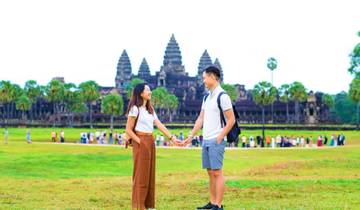
Private Angkor Wat Sunrise with All Angkor Highlight Temples 2 Days Tour
We had 6 days tour to see all highlights of Angkor temples and it was amazing to cover all important sites in and around Siem reap. Our guide Sara was excellent knowledge, friendly and helpful. We had nice hotel and large room, foods were delicious. Overall the services were excellent and great experience.
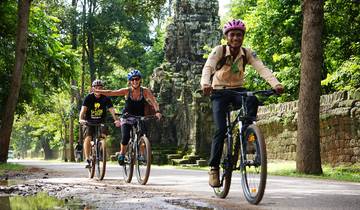
5 Days - Angkor Family Bicycle Tour
We had an awesome bike tour around Angkor Wat temples with Lot as our guide. Our bikes were extremely comfortable, the views were breathtaking, and the ride was amazing! I really appreciated the opportunity to see the cultural and historical aspects of Cambodian life that were brought up on this visit. It will be a great way to start our family holiday in Cambodia. Thanks for a great tour!!!
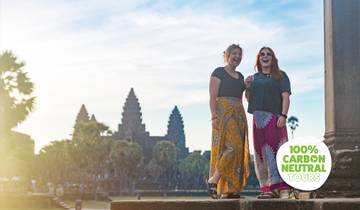
Cambodia Intro
I'm only 3 days into the Intro Cambodia tour but from the very first day since arriving Seyha has been nothing but outstanding. Having not travelled since Covid, I felt pretty overwhelmed travelling again but 3 days in and it's like a pandemic never happened Seyha has been so incredibly organised. From setting up whatsapp groups, to helping with all travel even in free time, his zest for being a tour leader is enviable. I'm really looking forward to what the next week has to bring, and will definitely be doing tours again in the future with Intro Travel
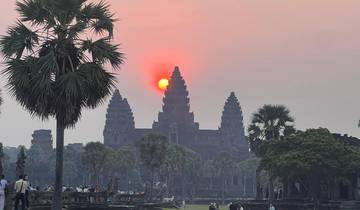
Private Siem Reap 3 Day Tour to Discover All Highlight Angkor Temples
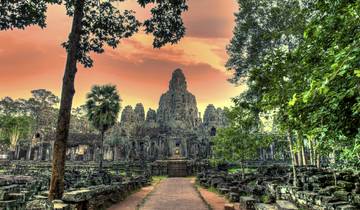
Best of Angkor 4-Day Tour
Excellent Service right from the Start of booking to the Finnish of the Tour; This was an amazing Holiday the Tour Guides and Drivers where brilliant.
- 10% deposit on some dates Some departure dates offer you the chance to book this tour with a lower deposit.
- Book With Flexibility This operator allows you to rebook your dates or tours with them for free, waiving change fees.
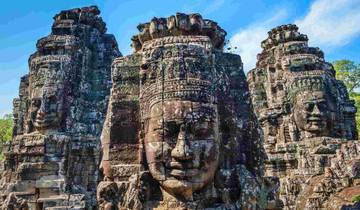
HIGHLIGHTS OF VIETNAM AND CAMBODIA - Hanoi City / Halong Bay / Siem Reap/Angkor
The tour was really absolutely great and very well organized for a solo traveler! The tour consists of several individual tours with different groups. You really see a lot of cities and learn a lot about the culture, country and life of the people there. My guide "Jenny" was really phenomenal and I have to say a big compliment and thank you! She organized the trip perfectly for me and was also very flexible when I had other wishes. She has always been very friendly and was almost always available and answered my questions quickly. Your team of guides were great too! I've met so many nice people and I'd like to say thank you to everyone! The hotel selection was also great. The single rooms I had were large and clean and really upscale for the standard! They were always centrally located, which I also found to be practical.Overall, as a woman alone in the country, I felt very safe and comfortable. All transfers from train to flight worked perfectly. There wasn't a single difficulty. I can really recommend the tour to anyone who likes to travel flexibly and more independently! The tour is also great for couples or friends. I was also able to do a lot of things on my own, which I found very pleasant. The groups were always 7-8 people, so it was never too much but always just right!! Thank you very much for everything!! I will highly recommend the trip!!

- Sightseeing
Temple Small circuit & Tonle Sap Lake Joining Tour
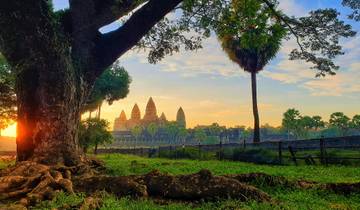
Private Siem Reap 2 Days Tour for Angkor Temples and Floating Village at Tonle Sap Lake
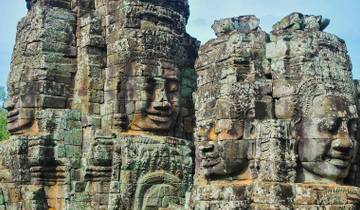
3 DAYS SIEM REAP PACKAGE (PRE or POST MEKONG RIVER CRUISE)
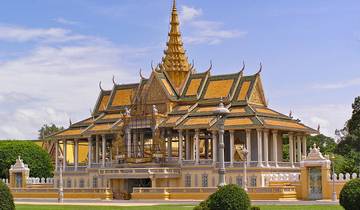
Classic Cambodia
Once we met up with the tour group, things went very well. We had just had a great tour in Thailand with Viator so this one had a lot to live up to. Accommodation was good, the meals that were provided were good (and supported teaching kitchens which was nice) and the tour guide (Li) was great. Negatives were: the booking of the initial transfer from the airport in Phnom Penh- it seems that 4 days is not enough advance warning to book a taxi from the airport to the hotel - and, the price is quite high for only a few meals covered (since the hotels provided breakfasts anyway) Other than those irritants, the tour was very good.
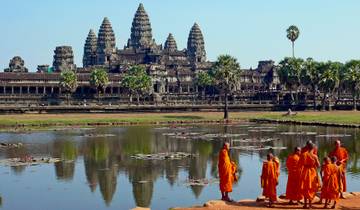
3-Days Angkor Temples - Cambodia
What people love about angkor wat tours.
Polite people, well organized and magnificent archeological sites
- to Asia (2)
- Cambodia Travel Guide | All You Need to Know
Royal Angkor Tours
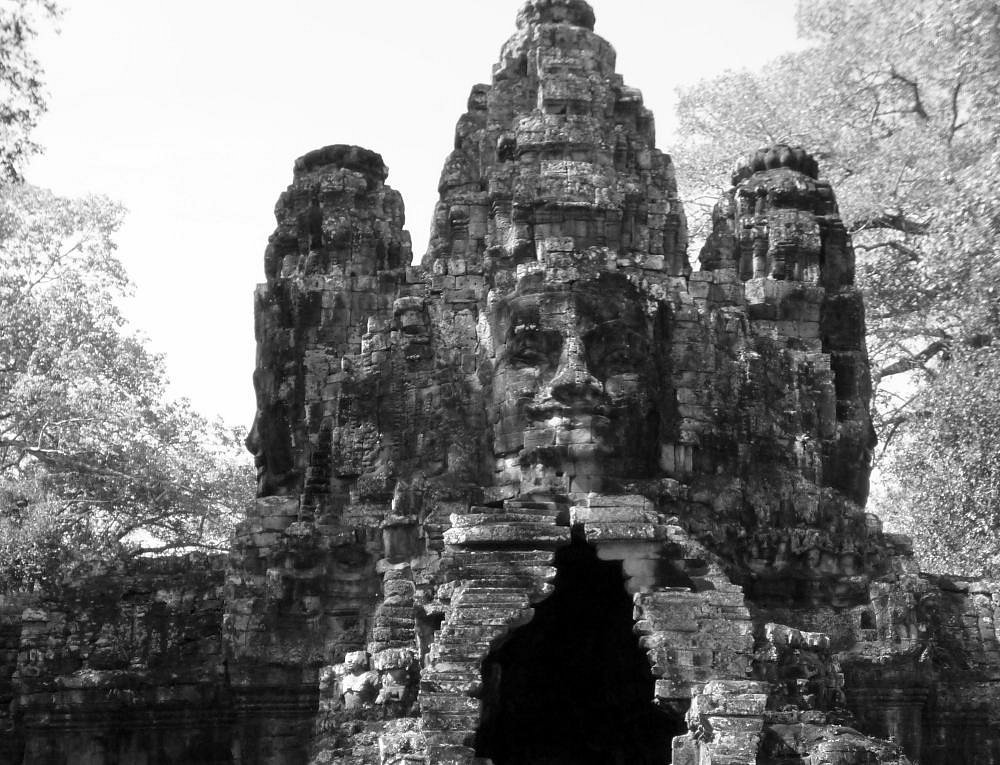
- See all photos

Private Angkor Wat One Day Tour - Best of Angkor

Multi-Day Private Tour Visiting the Best of Angkor Wat
Most Recent: Reviews ordered by most recent publish date in descending order.
Detailed Reviews: Reviews ordered by recency and descriptiveness of user-identified themes such as wait time, length of visit, general tips, and location information.
Royal Angkor Tours - All You Need to Know BEFORE You Go (2024)
Visit Angkor Wat: An Epic Travel Guide (Temples & Map)
A visit to Angkor Wat is something you’ll never forget. It’s massive. It’s impressive. It’s an amazing complex of well-preserved scattered temples and wats that showcase Khmer culture and beauty. The temples of Angkor Wat make up what is referred to as Angkor Archeological Park, which if you don’t know, is an explorer and history buff’s paradise.
From the well-known temples of Bayon (face temple) and Ta Prohm (tomb raider temple) to the lesser-known temples of Angkor Wat, we’ll provide you with a comprehensive travel guide so your visit to Angkor Wat is seamless. Be it information on Angkor Wat tickets, the best time to visit, or how to get there and around Angkor Archeological Park, we’re here to be your Angkor Wat guide.
Visiting Angkor Wat Temple & Travel Guide
Pin & Save For Later!
Jump Ahead To:
Angkor Wat Temple Facts
It’s always nice to understand what you’re about to experience, isn’t it? Below is a short but helpful list of essential Angkor Wat facts so you understand the basics before you arrive. Looky, looky whose coming prepared!
- Constructed in the early 12th century by the Khmer King Suryavarman II, Angkor Wat is one of the largest religious monuments in the world.
- The former Hindu, now Buddhist Wat, sits within a 400 square kilometers (154 square miles) complex that is known as Angkor Archaeological Park.
- Angkor Archaeological Park houses the remains of not only Angkor Wat itself, but the remains of the entire Khmer Empire dating back to the 9th – 15th centuries.
- The name “Angkor Wat” means “Temple City” or “City of Temples”.
- In the 15th century, the Khmer Kings abandoned their sprawling city and Angkor Wat laid forgotten for centuries. It wasn’t until a French explorer by the name of Henri Mouhot, rediscovered the Khmer city in 1860.
- In the early 1900’s the French established a commission to begin restoring Angkor Wat. To this day, restoration efforts are still underway, and a portion of ticket sales go to these restoration efforts.
Check out our Cambodia Travel Itinerary right here!
Where Is Angkor Wat & How To Get To There
The entire Angkor Wat Archeological Park complex is about 162.6 hectares / 401 acres in size and is located about 15 minutes (5.5 km / 3.5 mi) northwest of the city center of Siem Reap in Cambodia.
If you are not in Siem Reap yet, no worries. Siem Reap has an international airport (REP) so you can easily catch a flight into the city. Alternative options are to travel overland by bus . If you’re coming from Phnom Pehn or neighboring Thailand, there are loads of overland bus options for you to reserve and book. Once in Siem Reap, you’ll find no shortage of transportation options and guided tours that will happily whisk you to, from, and around Angkor Wat.
Best Way To Get Around Angkor Wat
If you are not planning on booking a tour of Angkor Wat, you have a handful of options on getting you not only to but around Angkor Wat.
A tuk-tuk from Siem Reap to Angkor Wat is the most popular option to take tourists to, from, and around Angkor Wat. You can easily hire a tuk-tuk for the day (or half-day) directly with a driver on the streets of Siem Reap, through your accommodation or local tour agency. Trust us, once you get into Siem Reap, you’ll see the plethora of Tuk-Tuk drivers offering their services to take you and your companions to visit Angkor Wat.
A round-trip Angkor Wat tuk-tuk price will cost you anywhere from $15 – $20 USD per day. If you pay closer to the $25 range, that is a little on the higher end, but up to you how much you want to haggle.
TIP: If you book a tuk-tuk with a driver on the street (like we did), do not pay him upfront. Wait to pay in full till the end of your trip. Regardless of who you book a tuk-tuk ride through, make sure the temples you want to see and how long you have the tuk-tuk for are clearly communicated and agreed upon upfront.
Private Van
Another option on how to get to and around Angkor Wat is booking a private van. Private vans provide air-conditioning and much more comfort than tuk-tuks. Also, you also have the nicety of having a tour guide accompany you as well.
To book a private van tour from Siem Reap to Angkor Wat, check out this private van tour here .
Bicycle Or eBike
The most cost-effective transportation option from Siem Reap to and around Angkor Wat is renting a bicycle. However, this is also the most labor-intensive. Temperatures in Siem Reap can be very hot and humid so please remember to stay hydrated while you cycle.
Also, to avoid any hiccups along the way, make sure the bike is sturdy. We’d hate for you to lose a tire along the way. Hey, it happens! Bicycle rentals vary but around $5 USD per day is average. A handful of accommodations have free bicycle rentals for guests and bike shops in Siem Reap offer day bike rentals.
Speaking of day rentals! An alternative to bicycling is getting a little assistance while you do it. eBike rentals are also available in Siem Reap. Regardless of how you choose to get to and around Angkor Wat, just know that walking isn’t an option.
Be sure to check out our 22 things to know before you travel to Cambodia here!
Angkor Wat Entrance Fees & Hours
When planning your visit to Angkor Archaeological Park you’ll need to determine how much time you want to spend in the park. You have three ticket options, each offering visitors different lengths of time:
- 1-Day Angkor Pass – $37
- 3-Day Angkor Pass (valid for 1 week) – $62
- 7-Day Angkor Pass (Valid for 1 month) – $72
Angkor Wat is open daily from 5:00am to 6:00pm . Whereas Phnom Bakheng and Pre Rup Temples are open from 5:00 am to 7:00 pm , and all other temples open at 7:30 am and close at 5:30 pm .
Angkor Wat Tickets – Additional Things To Know
- Children 12 and under can enter for free but must show a passport for proof of age
- Park tickets issued after 5 pm are valid for the next day
- The above 1, 3, and 7-day tickets options include entrance to all temples except Kulen Mountain and Bengmealea temple
- There is no ticket discount for groups
- All tickets require a photo of you, this ensures you cannot resell your ticket to another individual
- You can pay for your Angkor Wat ticket in cash or with a credit card (Discover, Visa, Mastercard)
Where To Buy Angkor Wat Tickets
Please understand that you can ONLY buy your Angkor Wat ticket from the Ticket Office Box. The Ticket Box office is not all that convenient to get to – 15 minutes from Siem Reap and 15 minutes from Angkor Wat. Tickets bought elsewhere are considered fraudulent Angkor Passes.
The ticket box office for Angkor Wat opens at 5:00 am and it would be in your best interest to get there before opening – around 4:30 am or 4:45 am. The ticket line can be loooong and if it’s too long, you could miss that beautiful sunrise you’re trying to get to. Luckily, there are about 20 window clerks cranking out tickets for tourists so your wait shouldn’t be too long, especially if you are one of the first in line.
Even though it takes about 15 minutes to get from Siem Reap to Angkor Wat, you need to take into consideration the amount of time it takes to get from Siem Reap to the Ticket Office, and then to Angkor Wat. On average, it takes around 30 minutes to get to and from all three, however, you’ll also need to take into consideration the time it will require you to buy your tickets. This is important when trying to plan for sunrise.
An alternative option is to buy your tickets the night before . Any tickets sold after 5:00 pm are valid for the next day . The ticket office closes at 5:30 pm so be sure to arrive around 4:30 pm to allow yourself the time you need to get in line and buy your ticket. Whatever you do, DO NOT BUY your ticket till after 5:00 pm. If you buy tickets before 5:00 pm, they’ll count for the current day and will not be valid for the next day.
Get our take on a perfect Angkor Wat itinerary right here!
Ticketing Check Points and Angkor Wat Ticket No-No’s
Whatever you do, don’t lose that Angkor Wat ticket of yours, and always make sure to have it on you. Why? It’s common to have your ticket checked by security at the entrance of certain Angkor temples.
If you lose, tear, or damage your ticket in any way, you’ll be required to purchase a new ticket at full price in order to gain access to the temples of Angkor Wat. Angkor Wat tickets are non-transferable and not meant to be resold. If you get caught selling your Angkor Wat ticket to another individual, you’ll pay a hefty fine.
Best Time To Visit Angkor Wat
January to May and then November to December are the best months to visit Angkor Wat. June to October is hit-and-miss months. During the months of June through October, the monsoon season is in full swing making walking around outside or seeing the Angkor Wat sunrise a bit of a challenge.
Regardless of which month you plan to visit, just make sure to start your day early. It gets extremely hot and humid in Cambodia so do your best to avoid sightseeing during mid-day. Plus, the early bird gets the worm as they say. Morning is not only great lighting for photos but tends to be a little lighter on the crowds.
How Long Do You Need To Visit Angkor Wat
How do you know which ticket option is best for you when visiting Angkor Wat? Well, it’s a personal preference. Our recommendation is to buy a one-day or three-day pass. Ask yourself the below questions and we promise, it’ll help you decide.
- Short On Time: Get you that one-day pass to Angkor Wat.
- Have A Few Days: Go on and buy that three-day pass or hell, the week pass if you have the time.
- Tight On Money: The one-day pass is $37 per person so even on a budget, that’s pricy.
- Have Some Funds to Spare : The three-day pass is going to set you back $62 per person but if you have the time, it’s worth it.
- Only The Highlights, Please : One-day pass for sure.
- Let Me See It All: If you are a history buff and seriously love ancient ruins and temples, then there are plenty of sites to keep you occupied. Get that three-day or seven-day pass.
Do You Need A Guide To Visit Angkor Wat?
First, understand that you do not need to book a tour to experience and visit Angkor Wat. Booking your own transportation and determining what Angkor Wat temples you want to see can be completely done by yourself.
However, take it from us, we got SO much more out of our visit by having a guided tour of Angkor Wat. You can reserve a guided tour of just Angkor Wat or look to book a guided tour through the entire park so you can get the history of each Angkor Wat temple you wish to visit.
Angkor Wat Tour Routes – The Grand Circuit and The Small Circuit
Alrighty, so what we’ve come to learn about Angkor Wat is there are established tour routes referred to as The Grand Circuit or The Short Circuit. While these are established routes, they are also totally customizable, especially when you hire your own Tuk-Tuk driver or book a private tour to take you around the park.
Before paying for either the Tuk-Tuk or the private tour , BE SURE to agree on any modifications you’d like to make to the below routes to ensure you see the Angkor temples you want to see. Having these conversations upfront ensures you are not surprised later by either having to pay more or risk not seeing a temple you had your heart on exploring.
The Small Circuit Tour
Great for those who only have one day in the park. The Small Circuit route covers the major highlights of Angkor Wat Archeological Park.
- Bayon Temple
- Baphuon Temple
- Terrace of the Elephants
- Banteay Kdei
Two popular guided tour options are to start the Small Circuit tour with sunrise or to start a little later to experience the Small Circuit with sunset . Whichever you decided, you’ll be whisked around Angkor Wat temples and shown some of the very best Angkor Wat has to offer.
There are two other Angkor temples that sometimes are or are not included in these routes, it just depends on your tour guide or Tuk-Tuk driver. But if of interest, it’s worth seeing if you can add Srah Srang and Phnom Bakheng to your Small Circuit route.
The Grand Circuit Tour
Unlike the Small Circuit route, the Grand Circuit route (also called the Big Circuit) includes a handful of Angkor temples on the outskirts of the complex. The below list of Angkor temples is often less visited by tourists when compared to the temples on the Small Circuit.
- Neak Pean (or Neak Poun)
- Banteay Prei
- Banteay Srei
- Banteay Samre
- Pre Rup
If you are looking to experience the temples on both the Small Circuit and Grand Circuit , you can coordinate with a Tuk-Tuk driver or look into booking a tour like this one , where over two days you’ll be whisked around Angkor Wat and the most popular set of temples. Or, if you’re just wanting to explore the Grand Circuit route, this is a great guided tour to check out.
Angkor Wat Temples Not To Miss
So now, with all the route talk said and done, really and truly the temples you want to see are up to you. We worked with our tuk-tuk driver and pulled from both the Small Circuit and Grand Circuit to see the temples we wanted to see.
Fair warning, there are several hundred temples and ruins that lay within the boundary of Angkor Archeological Park. Yes, that’s indeed a lot and can become a bit overwhelming when looking to find the best temples to visit in Angkor Wat. Below are not only the most popular Angkor Wat temples to visit , but the below also cover the most beautiful park highlights as well.
- Sunrise at Angkor Wat
- Angkor Thom
- Sunset at Pre Rup
Be sure to coordinate with your Tuk-Tuk driver to ensure the temples you want to see are understood and included in the price they give you. Same for a private tour , work with the tour company to ensure you see what you want to see.
Where To Watch Sunrise At Angkor Wat
Alright, being honest, there really is only a handful of places you should consider for sunrise. Also, it’s important to mention that not all Angkor Wat temples are open at the same time. So really, your options are limited as to where you can watch the sunrise.
If you are wanting to catch a sunrise at a temple not listed below, be sure to check its hours to make sure you can access the temple during the early hours of the morning.
- Angkor Wat Reflection Pond (Open at 5 am ): The most popular choice for sunrise in Angkor Wat is to see the sunrise over Angkor Wat and as the sky illuminates, watch the pond in front of Angkor Wat give a wonderful reflection of the scene appearing in front of you. Just know, sunrise here is BEYOND crowded. You will be shoulder to shoulder with people striving to see the same view as you, that famous Angkor Wat reflection pool sunrise. So, if you want to get a good seat, arrive early and hold your own as tourists begin to arrive.
- Pre Rup (Open at 5am): Pre Rup opens early for visitors to climb to the top for sunrise where you can find a spot to perch and watch the sunrise over the ruins and jungle below.
- Phnom Bakheng (Opens at 5am): Another option to watch the sunrise at Angkor Wat is Phnom Bakheng. This temple offers a high vantage point with views of Angkor Wat in the distance.
Get our tips for catching the sunrise at Angkor Wat!
Where To Watch Sunset At Angkor Wat
Like sunrise, only a handful of temples are open late enough in the evening for you to catch a sunset. Three of the most popular places to watch the sunset in Angkor Wat are listed just below.
- Pre Rup (Closed at 7pm): In the direction the sun sets, you’ll be watching it dip below a jungle tree line, but nonetheless, it’s pretty cool to watch the sunset from the top of an Angkor temple. Pre Rup is a close second to the most popular temple for an Angkor Wat sunset.
- Phnom Bakheng (Closes at 7pm): The most popular location in Angkor Archeological Park for sunset is Phnom Bakheng. Fair warning though, there are only 300 people allowed at a time in the temple to watch the sunset. So, if your heart is set to watch the sunset here, arrive a few hours early to not only get temple access but a good spot.
- Srah Srang (Closes at 5:30pm): Popular for sunset as the light and colors of the sky will light up the reservoir or Royal Bath that makes up Srah Srang.
Regardless of if you want to see the sunrise, sunset, or both, BE SURE to check the weather . If the forecast calls for rain or overcast, you might be out of luck. We’d hate for you to wake up early and not get to see the sunrise over Angkor Wat.
Angkor Wat Dress Code
Yes, these temples are ruins but that still doesn’t mean you can dress how you want. These are active religious sites still used by practicing Buddhist and Buddhist monks. So, your behavior and attire should be respectful.
- Knees and shoulders should be covered
- Feel free to wear a tank top but just bring a sarong or scarf to cover your shoulders when entering the temples
- Shoes are accepted, no need to go barefoot
- Shorts are fine
- Keep those shoulders covered aka no tank tops
We know, we know, Cambodia is hot, and shorts and tanks are amazing for that hot weather, but these outfit choices are not appropriate clothing for Angkor Wat. Be respectful and you’ll be just fine.
What To Bring With You To Angkor Wat
- Water : It is hot, and you’ll be doing a lot of walking so make sure you have plenty of water on you.
- Day pack: You’ll definitely want a comfortable backpack to carry your items, food, and water.
- Camera : Definitely do not leave this back at your room. Also, if you have extra batteries, be sure to pack those too.
- Sunscreen : Lather up your face and body. The sun is intense and since you plan on spending a full day exploring outside, make sure you apply several times throughout the day to keep you from looking like a crispy lobster.
- Sunglasses : Again, the sun. Protect those eyes and make it easier to see.
- Hat (if needed) : Yup, the sun again. Hats help block the sun further and provide you a little shade.
- Angkor Wat Ticket : 100% don’t leave this back in your room or you won’t be getting very far.
- Bug Repellent : You’re in the jungle after all, aren’t you? Don’t make yourself a mosquito snack. Pack and apply buy spray.
- Cash: There are food stalls and restaurants in the park, bring some cash for food and tips for your tour guide or driver.
- Wet Wipes or Hand Sanitizer : Meh, it’s dusty and you’re going to touch a lot of things other people have touched. It’s nice to have some clean hands when you take a break for lunch or to eat any snacks.
- Power bank : More than likely you are going to be out all day, and no one likes it when their phone dies. Bring a power bank to keep your phone or any other gadgets charged.
- First Aid Kit : We always have one with us in our day bag. It’s SO nice pull out a Band-Aid to cover up blisters of some Tylenol when you have a headache. We don’t want you to have a cut or headache and have to go searching for relief when you could have something in your pack instead.
- Snacks : Plain and simple, no one likes to explore when they’re hungry.
Tips For Visiting Angkor Wat
- Do not ride the elephants . Just don’t. That’s animal abuse and it’s cruel so please avoid elephant rides and tours at Angkor Wat and everywhere else you travel too.
- Dress appropriately . Be respectful in your attire (cover your chest/cleavage, shoulders, and knees) if you want to gain access to temples in Angkor Wat.
- Stay Hydrated . Ya’ll we can’t stress enough how hot it can get. Just make sure you have plenty of water and more importantly drink the water.
- Plan Ahead . Know which temples or route you want to take, book tours or guides, and have a plan for when you want to buy your tickets. Laying out a plan will take any stress of your visit away.
- Wear comfortable shoes . You are going to be doing LOADS of walking, so be sure those little feet of yours are supported.
- Be Wary of Fake Tour Guide s: You may get approached by kids or adults offering to take you on a personal tour of “x” temple you are currently exploring. Politely, but assertively decline as these are not certified guides.
Angkor Wat Temple Map
Below, you’ll find an interactive map showcasing the temples traditionally shown during the Small Circuit route as well as the temples typically shown on the Grand Circuit route. Click on the map to show what temple is what as well as zoom in and out to get a feel of the space and the complex of Angkor Wat.
Accommodations Near Angkor Wat
Siem Reap offer’s plenty of accommodation choices for those looking to explore Angkor Wat. With the city center of Siem Reap is only 15 minutes away, staying in Siem Reap is a great choice when booking accommodations . However, if you are wanting to stay outside of the city, there are accommodations near Angkor Wat for you to consider.
For The Budget Conscious: Looking for a humble stay? Well, look no further than Sok Phen Homestay or Dany’s Angkor Cottage . Stay in humble abodes situated in the Cambodian countryside. Enjoy cooked meals and sweet serenity at Sok Phen Homestay or Dany’s Angkor Cottage .
For The Luxury Inclined: Templation Hotel , is a luxury getaway close to Angkor Wat. With lovely rooms, an amazing pool, beautiful gardens, and friendly staff you’re in for an unforgettable stay.
For Something In Between : Located a few miles from Angkor Wat, you’ll find the beautiful Grand Venus La Residence . Grand Venus La Residence is a modern hotel featuring a massive pool and beautiful surroundings far from the noise of Siem Reap.
For more places to stay near Angkor Wat, you can check out the latest places and prices here .
WANT MORE INFORMATION ON CAMBODIA?!
Kampot, Cambodia: Your Complete Travel Guide
9 Amazing Things To do in Battambang, Cambodia
6 Tips For Seeing Angkor Wats Sunrise
Cambodia Tips: 22 Things To Know Before You Visit Cambodia
Volunteering at a Cambodian School
PIN IT FOR LATER!
For more travel tips, guides, and awesome travel shots, be sure to poke around our site, follow us on Instagram @wanderingstus, Pinterest on Facebook . Oh and if you have any questions, let us know in the comment section. We’re happy to answer. Or, just leave us a positive note!
Happy Travels,
– Lauren & Jesse Stuart (The Stüs)
We're Lauren & Jesse, the creators behind Wandering Stus! We've been traveling for decades, exploring and experiencing the very best this world has to offer. Whether we're roadtripping the U.S. in our camper, hiking through National Parks, or jet-setting to different countries around the globe, we write detailed travel guides to help you plan one amazing (and unforgettable) adventure!
Questions?! Let us know. Leave us a comment! Cancel reply
This site uses Akismet to reduce spam. Learn how your comment data is processed .

Angkor Wat Tours & Travel Packages 2024/2025
Our 215 most popular angkor wat trips. compare tour itineraries from 87 tour companies. 769 reviews. 4.8/5 avg rating., popular angkor wat tours.

Glimpse Of Indochina In 15 Days
- Enjoy an overnight cruise in the stunning Halong Bay
- Cycle around the villages of Vietnam and attend a cooking class
- Explore the biggest temples complex in the world, Angkor Wat
- See cascades waterfalls right in the middle of lush jungles

Best of Thailand, Cambodia, and Vietnam Tour
- Soak up the exotic charm of Thailand's capital city - Bangkok.
- Interact with the amazing elephants in a way of responsible travel
- Indulge in the extraordinary seascape of Ha Long Bay
- Learn about the turbulent history of Ho Chi Minh City
- Learn about Mekong Delta's farming and fishing traditions

Angkor Wat & Thailand Essential
- Wander amid the vine-covered courtyards of Angkor
- Visit the glittering Grand Palace of Bangkok
- Get close to gentle Thai elephants in Chiang Mai
- Sunbathe on the golden sandy beaches of Phuket

12 Days Vietnam and Cambodia Discovery
- Sail through the enchanting Halong Bay, exploring its mesmerizing caves and islands.
- Relax in the historic ambiance of Hoi An and visit the awe-inspiring My Son Holy Land.
- Experience the bustling energy of Ho Chi Minh City and the tranquil beauty of the Mekong Delta.
- Embrace the warm hospitality of the locals in Siem Reap.
- Delve into the architectural marvels of Angkor Wat and Angkor Thom.

Discover Asia
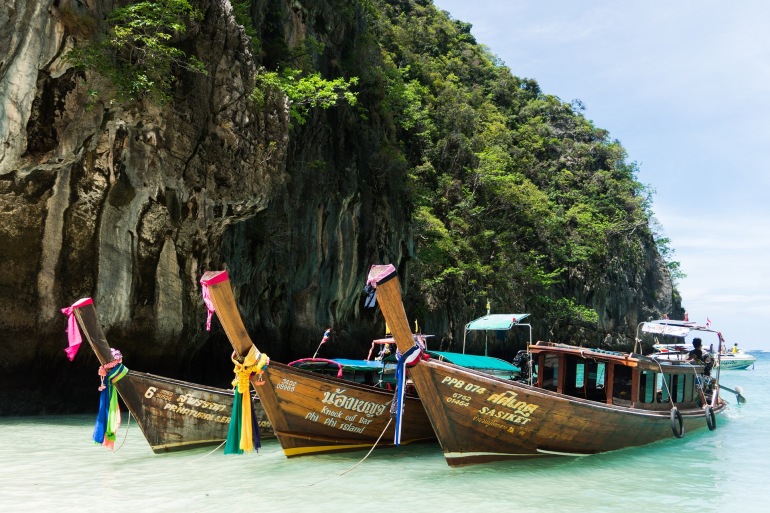
Spirits Of Vietnam - Cambodia -Thailand In 17 Days
- Enjoy an overnight cruise at the UNESCO World Heritage site
- Take a ride in a traditional Vietnamese unique basket boat
- Explore the largest religious monument in the world - Angkor Wat
- Sit back for a relaxing time at the stunning beaches of Phuket

14 Days Authentic Vietnam and Cambodia
- Explore the rich culture and history of Hanoi's Old Quarter.
- Spend a night cruising through the majestic landscapes of Halong Bay.
- Experience the serenity of Hoi An's ancient town.
- Discover the impressive tower temples of My Son Holy Land.
- Immerse yourself in the bustling atmosphere of Ho Chi Minh City.

Unveiled Cambodia: Khmer Culture and Beach
- Immerse yourself in the rich Khmer culture of Siem Reap and Phnom Penh
- Witness the mesmerizing sunrise at the renowned Angkor Wat heritage site.
- Embark on a delightful cycling journey through the picturesque Cambodian countryside.
- Unwind on the picturesque shores of Koh Rong.
All Angkor Wat , expedition cruises, self guided adventures and vacation packages. Find the best guided and expert planned vacation and holiday packages. Read more about Angkor Wat

Small Group Angkor Wat Tours

Cambodia Highlights
- 8-day Cambodia highlights trip to the vast temple cities of Angkor and capital Phnom Penh
- Learn about Cambodia's dark history of the Khmer Rouge in its French influenced capital
- Discover floating villages and stilt houses on a cruise of Tonle Sap Lake

Cambodia Adventure
- Visit the Kampot pepper plantations
- Relax and unwind on tropical Koh Rong island
- Board a bicycle rickshaw for a tour through Phnom Penh and along the banks of the Mekong River
- Visit the Killing Fields and Tuol Sleng Prison
- Cycle through the countryside of Battambang

Discover Southeast Asia
- Enjoy a traditional khantoke dinner in a rural village
- Enjoy a visit and talk with a monk at an historic chiang mai temple
- Have lunch at a training restaurant for disadvantaged youth
- Witness an outstanding performance at phare (the cambodian circus)
- Take thrilling cyclo rides for a different perspective in bustling cities
Best Angkor Wat Tours by Duration
Tours, Cruises & Private Trips
Best Angkor Wat Tours by Price
Top Angkor Wat Attractions & Experiences
Top Angkor Wat Experiences
- Exploring the temples
- Watching the sunset at Phnom Bakheng
- Taking a ride in tuk-tuk
- Looking at the wall art that tells the story of Kurukshetra battles
- Spending a night in Siem Reap
- Meeting a monk
- Seeing the Bayon at Angkor Thom
Angkor Wat Tours & Travel Guide
Angkor Wat Attractions & Landmarks Guide
The world’s largest religious complex, Cambodia's Angkor Wat (which means “City of Temples”) covers some 500 acres. At one time, 750,000 people were said to live on the site, but it’s been abandoned for centuries.
It was built by a Khmer king in the 12th century as a Hindu temple, and later served as a Buddhist shrine and place of pilgrimage. Its remarkable stone structures -- with spires reaching heavenward and walls lined with bas-reliefs and other artworks -- lie amid the forests near the Cambodian city of Siem Reap.
Visiting Angkor Wat is a top itinerary item for tours to Cambodia , but be prepared for a lot of crowds.
A common misnomer is that Angkor Wat and Angkor are the same thing, when in fact Angkor Wat is just one temple in the enormous ruin city, and UNESCO World Heritage Site, city of Angkor.
Countless temples are strewn throughout the temple complex, and even with several days to spend exploring, it's impossible to see them all. Below we’ve compiled a selection of some of the unmissable temples. You could reasonably see these, plus the crown jewel of Angkor Wat itself, in two days, but if you’re one to prefer taking your time to explore and especially if you enjoy travel photography, you definitely will want more time than that.
The Main Temple of Angkor Wat
The most famous of the Angkor temples, and the one after whom the temple complex is named, Angkor Wat is instantly recognizable. But pictures will not do the temple justice, and the sight of the gigantic towers and sprawling grounds are far more impressive in person. It's worth the effort to make it to the temple by sunrise, to watch the sky change color above the imposing towers. Or better yet, take a ride in a hot air balloon to take in the view from the air.
Built between the years 1130 - 1150, the temple of Angkor Wat is the most famous and well known perhaps because it is still in use today. A Hindu temple designed to represent the home on earth of the gods, its massive scale is truly impressive.
Most historians agree that the temple was used both as a tomb and temple, a fact supported by its western facing carvings and doors, and the bas-reliefs were designed to read in a counterclockwise direction.
To protect this magnificent site, be respectful of areas that are off limits, dress appropriately, and take your time. The many gorgeous carvings along the walls reveal epic stories, myths, and describe a people close to their religion and extremely devoted. Breezing through to check the site off your bucket list will ultimately leave you disappointed and rushed - this is a site which begs to be examined and appreciated for all its historical significance and beauty.
How to Get to Angkor Wat
Angkor Wat is actually the large main temple within the ancient city of Angkor, which is what you’ll actually spend more time exploring during your visit. These fascinating ruins became an UNESCO World Heritage Site in 1992, though despite valiant and ongoing efforts to keep them in as good shape as possible, a continuously growing influx of tourists have made protection an enormous challenge.
Tours to Angkor Wat typically leave from Siem Reap, which is about a 20 minute drive away. There are several ways you can arrange to see the site, including renting a car, renting a bike or motorized scooter, or going by hired tuk-tuk. Walking is not recommended, only because the heat can be intense, and you’ll be walking by multiple moving vehicles going at different speeds, and some places have very little sidewalk.
Renting a car can provide a nice breather between temples as you enjoy a reprieve in the air conditioning. But if you can stand the heat, the cheaper options are nicer as you have less crowds to deal with as you try to park.
There are 3 different passes you can decide between, once you arrive at Angkor. A Day Pass, A Three Day Pass, and a Week Long Pass. (The US dollar is widely accepted throughout Cambodia).
Forget any illusions you may have about Angkor Wat being empty and devoid of other people. It will definitely be full of other tourists exploring the ruins. Even the much lauded sunrise tour, to be among the first to get to the site, is a deceivingly busy activity. Though you may elect for this opportunity, you won’t necessarily be getting to the site when “no one else is there” which is how some tours sell this experience.
What to Wear for Angkor Wat
To visit the temples of Angkor, appropriate and respectful attire is expected. This includes long pants covering the knee, and covered shoulders. There are guards at each temple entrance (they will require you to show your pass, so they can add a punch to it) and they have been known to refuse entry for improper attire.
One major thing to keep in mind is the heat - particularly considering that you will be wearing conservative attire. Given this, try to find clothing that breathes easily, and doesn’t cling. Avoid cotton and other materials that are absorbent and thick.
High humidity is uncomfortable no matter what so anything you can do to minimize feeling icky is helpful - remember, you’ll be outside for the vast majority of your Angkor Wat tour. Make sure you bring a lot of water, and wear comfortable walking shoes. Exploring Angkor requires extensive, very steep stairs, so you’ll want good shoes, ideally with ankle support.
Cambodia remains fairly warm throughout the year, however there are some differences in wet vs dry seasons. The humidity is the highest during the hot and rainy season, between June and August. This is going to be quite uncomfortable for traveling, especially if you’re not use to humidity. It also coincides with summer in the northern hemisphere, which is one of the busiest travel times of the year, so the crowds will be heavy.
March through May is also quite warm, coming off of the cool season. Temperatures range in the 70s and 80s F, with high, but mostly bearable humidity.
The ideal travel months in terms of weather in Cambodia are November through February. This is the dry season, and you’ll also experience fewer crowds. During this time, temperatures average between high 60s and 70s F, with less humidity.
Temperatures are also cooler between September and November, and it is less humid, but it will most likely be wet and rainy.
Photography Tips for Angkor Wat
The spires, steps, carvings, and countless pathways at Angkor Wat create unbelievable compositions for stunning photographs. Photography enthusiasts, amatuer through to professional will always find something new to capture through the lens at Angkor Wat.
Here are some top tips for getting the best photos out of your Angkor Wat visit:
1. Bring multiple lenses - Angkor is one of those rare destinations that offers incredible variety for the type of photography you want to do. A telephoto lens will help you get up close with the many wall carvings and intricate designs within the temples. While a wide angle will be ideal for capturing the depth and scope of the temples and city.
2. Go on a photography tour - Especially for enthusiastic amateurs looking to bring their photographs to the next level, a photography tour is the perfect avenue to learn. Not only will you be able to visit incredible sights, you’ll have the opportunity to learn from a professional. And in a place like Angkor, where there are so many small walkways, multiple temples, and multiple views, your guide will know all the best places for photographs, including those that are “hidden.”
3. Lens cloth - in humid weather, like that you will experience in Cambodia, lens fogging is common. While this can create an interesting effect, it may not be the one you intend. Bring your camera out of it’s protective bag a good few minutes before you plan to shoot, and have a lens cloth handy throughout the day.
4. Comfortable neck/shoulder strap - Angkor Wat is full of incredible photo opps, and you will quickly get exhausted with pulling your camera out every 5 seconds. It is also typically very humid, and your generic camera strap may get itchy and uncomfortable in the heat. Fashion yourself a personalized lens strap with any kind of durable, soft, water resistant material to help with the burden of carrying your camera all day long.
5. Filters - Especially if you elect to do the popular sunrise tour at Angkor Wat, consider a filter to help display the subtle color and lighting of the sky as effectively as possible.
6. Practice shooting in shadow . Angkor provides a lot of wonderful opportunities for dramatic contrasts and sharp light shafts. Get to know your camera’s manual settings, and possibly practice with an external flash. You won’t want a strong flash, but one used with a diffuser might help bring out details in your shadowy photographs.
7. Bring a monopod - You will be walking around a lot in the hot sun, and a tripod will get cumbersome. And you don’t really need one for Angkor, as you’ll find many places to place your camera to keep it steady, or use a monopod. You’ll definitely want this option for shooting extended exposures in low light, but for the most part, it should suffice rather than a bulky and heavy tripod.
8. There will be people around . Embrace the fact that there will be a lot of crowds. You can pretty easily manage to get some pictures without people that are tight in portrait style, but your wide shots will almost certainly have people in them.
Angkor’s Other Temples
Angkor Wat is the most famous of the Angkor temples, and the one most people initially visit to see. However upon arriving, it may quickly become apparent that there’s so much else to see, and that Angkor is far more expansive than often thought by first time travelers.
Bayon Temple
The massive stone faces that adorn Bayon temple set it apart from the many temples of Angkor. Take your time exploring the different levels, as there are 214 of these faces to be found. Bayon was built in approximately 1190 AD, a Buddhist temple which incorporates Hindu elements as well.
Take your time as you explore the outer wall of this temples first level. Unique and intricately detailed carvings depict everyday life for the people of the time. As you continue through in a clockwise direction you’ll pass more panels depicting various tasks, important events (such as soldiers going or returning from war), and customs. Certain details seem much unchanged to the way provincial Cambodians live today.
Ta Prohm Temple
Ta Prohm, with its crumbling walls and jungle setting, gives visitors the sense that they have stumbled upon the ruins of a lost city. Gigantic trees entangle themselves among the rocks, and visitors can enjoy exploring and clambering over the massive roots. Some of the best photo opportunities can be found here, as the endlessly fascinating and foreboding theme of nature overcoming man made structures to reclaim the land once again is prevalent. This is also the famous “Tomb Raider Temple” as a famous shot from the entertaining franchise featuring Angelina Jolie took place here.
Built in 1186, Ta Prohm is one of the only Angkor temples to provide inscriptions within the stone walls that give an indication of why it was built, and a record of its inhabitants. It was built in dedication to the mother of Jayavarman VII.
Preah Khan Temple
Ta Prohm can become crowded quickly as it is the more well known of the overgrown temples to see. Preah Khan provides a wonderful alternative where fewer tourists venture. In a similar overgrown style to Ta Prohm, visitors can often enjoy having Preah Khan to themselves and feeling like a true explorer.
This temple, the name of which means “sacred sword” most likely served as the temporary residence of Jayavarman VII while his bigger home was in the process of being built.
Preah Khan was dedicated to over 500 divinites and hosted no less than 18 festivals during the year. While it was active, thousands of people lived and worked here to help maintain the space, as it saw so much buzz and activity.
Prasat Kravan Temple
Though on the smaller end of the Angkor temples, Prasat Kravan packs a punch. Especially when it comes to the beautiful and intricate stone carvings on the walls of its interior. This is a Hindu temple, built in the year 921, unique for the fact that it was not built by or for royalty at the time. It is set apart from the main complex, but it you have extra time during your Angkor exploration, dedicate it to Prasat Kravan.
Phnom Bakheng Temple
Built on a hilltop overlooking the temple complex, Phnom Bakheng is an ideal location from which to watch the sunset. Though make sure you allow enough time to get there early - 4pm is a good bet - as only 300 people are allowed up to the main sunset viewing area at one time. This is strictly enforced for safety as well as preservation. The sunset from this vantage point is well worth it however, so try to calculate it into your Angkor tour.
This was the first temple-mountain built in Angkor, for the ruler Yasovarman I. It has five tiers and seven levels, representing the seven Hindu heavens.
Angkor Wat Reviews & Ratings
Above our expectation.
It was a marvellous trip for us in Indochina. Everything was above our expectations except for the vegetarian food for my wife. The itinerary was perfectly organised...
Good choice to South East Asia
I will HIGHLY recommend this tour to my family, friends and work colleagues who are thinking about travelling to Vietnam and South East Asia – and will personally re...
Fanstastic itinerary
Wow! I couldn’t have asked for a better trip! Thank you so much. The cities were fantastic as were the rural and water based adventures. The tours and gu...
Warmest greetings from Australia
We made it back to Australia and our home town safe and sound. It is a three hour drive to my home town from Brisbane and I didn’t think it was safe for me to make ...
Best travel consultant ever
All of the tour guides were brilliant – Tony in Hanoi and Sody in Cambodia were my personal faves. All the guides spoke very good English, were very friendly, court...
See all Angkor Wat reviews
Related Trips & Tours
Angkor wat tours faq.
1. Does Travelstride have all the tour operators?
2. How does the Member Savings program save me money?
3. Can I trust the tour operator and trip reviews on Travelstride?
4. What does ‘Stride Preferred’ mean?

Angkor Wat: Guide to the Grand Circuit Tour
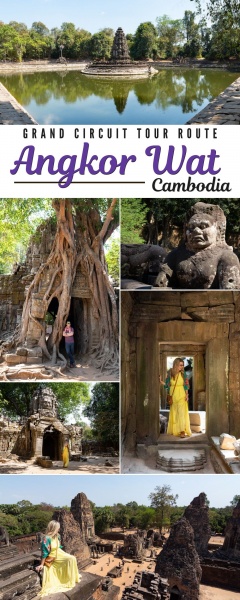
The Angkor Archaeological Park is massive – 400 square kilometers to be exact. And figuring out what temples to visit, how to get there, and how to avoid the crowds and the heat can be a daunting task. We purchased the 7-day pass so that we could explore all of it in order to bring you a complete guide to the Grand Circuit Tour, as well as a few other things you should know before you visit.
After you finish reading this post, be sure to check out our Complete Guide to Angkor Wat and our post about the Small Circuit Tour. And, of course, you’ll want to read all about the best places to eat, sleep, and drink in the nearby town of Siem Reap!
Disclaimer: This post may contain affiliate links. If you make a purchase or booking through one of our links we may earn a small commission (don’t worry, it’s at no extra cost to you).
Angkor Wat: Grand Circuit Tour
Entrance prices and hours, angkor archaeological park entrance fees.
- 1-day ticket – $37 USD
- 3-day ticket (valid for 1 week) – $62 USD
- 7-day ticket (valid for 1 month) – $72 USD
Angkor Archaeological Park Hours
- Angkor Wat Temple and Srah Srang: 5 am – 5:30 pm (open for sunrise)
- Phnom Bakheng and Pre Rup Temples: 5 am – 7 pm (open for sunrise and sunset)
- All other temples: 7:30 am – 5:30 pm
Ticket Office
The ticket office is technically open from 5 am – 5:30 pm daily. However, ticket agents usually begin selling tickets at 4:30 am so you can arrive even earlier if you want to get a prime sunrise-viewing spot. Or better yet, purchase your ticket between 5 pm and 5:30 pm the evening before so you don’t have to worry about waiting in line!
Choosing a Tuk-Tuk Driver
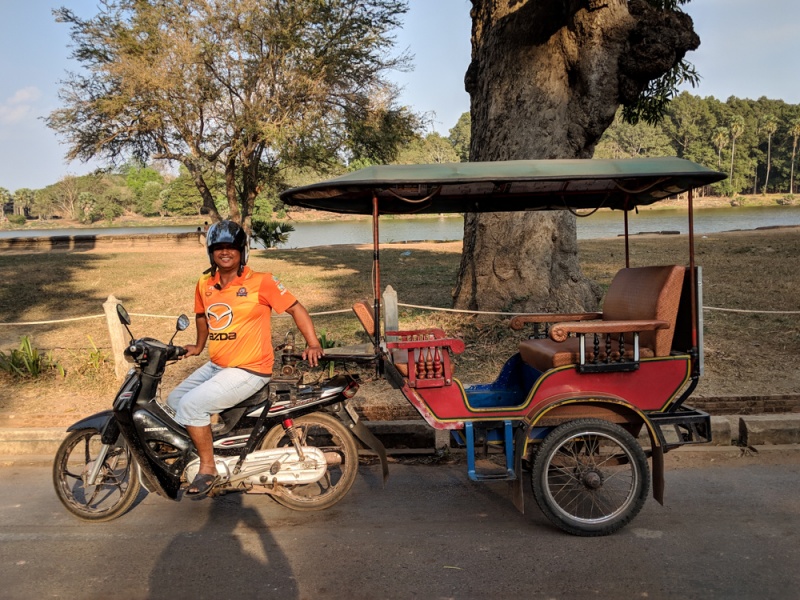
There are tuk-tuk drivers all over Siem Reap, vying for the chance to be your tour guide of Angkor Wat. They are especially congregated around the entrances of Pub Street, the popular backpacker area.
If you want to take a run-of-the-mill-tour, you can simply choose any driver that seems nice, no matter their level of English. They will point to their handy laminated map to show you the two options and quote you a price.
If you want to deviate from the normal route or watch sunrise somewhere other than Angkor Wat, you’ll need to find a driver that speaks decent English. Which may cost up to $30 USD for a trip. You can always rent a motorbike or bicycle and explore on your own.
The Best Tuk-tuk Driver in Siem Reap
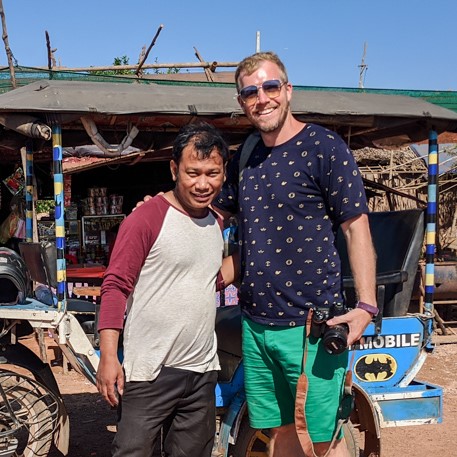
After several trips to Siem Reap we have worked with quite a few local drivers and our favorite Siem Reap tuk-tuk driver is Nakry Mean who drives a batmobile-themed tuk-tuk. You can reach him on WhatsApp at +855 17 761 110 or on his Facebook page, Siem Reap Batmobile Tuk Tuk .
Book a Tour of Angkor Wat
If you’d prefer to prearrange a tour of the temples, check out Get Your Guide. They offer a full-day Grand Circuit photo tour that starts with sunrise. You’ll have a knowledgeable English-speaking guide and learn all about the history of the park and the temples that you visit.
Book a Grand Circuit Full-Day Photo Tour
Grand Circuit Tour Route
The Grand Circuit Tour route (also called “Big Circuit”) is generally done clockwise and includes the temples that are outside of the Small Circuit Tour . These are on the outskirts of the complex so it’s a bit more expensive as your tuk-tuk driver will use more petrol. Read more about those temples in our post about the Small Circuit Tour .
We chose to modify our Grand Circuit tour. We started with sunrise at Srah Srang, a small temple that sits on the banks of a big man-made lake. Then we added Ta Prohm to our list of temples that we would be visiting. And we did the tour in counterclockwise order.
The temples below are listed in order of how you would visit them if you started with sunrise at Angkor Wat and toured in clockwise order.
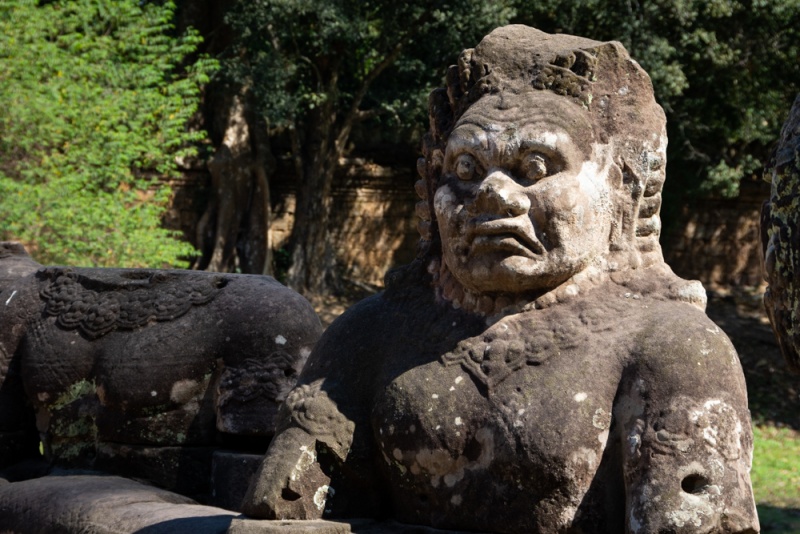
Preah Khan is definitely one of the highlights of the Grand Circuit Tour. The walkway leading up to Preah Khan temple is lined by statues that appear to play tug-of-war with a snake; they are actually depicting the churning of the ocean of milk. It is a grand entrance to a very grand temple.
As you walk through the central hallway through Preah Khan, it seems to go on and on forever. But soon enough it opens up and you’ll find little pockets of areas to explore here. The carvings are still in very good condition and much of the temple is just a free-for-all to explore. These carvings of women goddesses in dancing poses are known as Apsara.
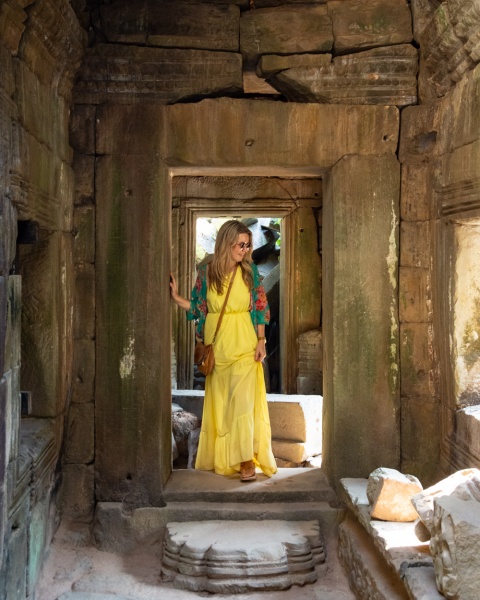
It was one of my favorite temples in the complex because there seemed to be a surprise around every corner. It’s a good one to check out in the morning before you are sweaty and exhausted and can only think about air conditioning and a cold beer.
Opening Hours: 7:30am – 5:30pm
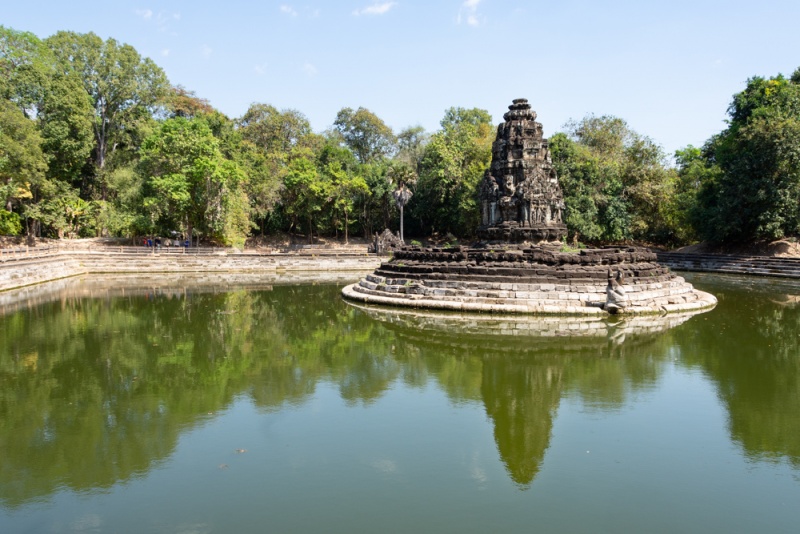
You’ll walk along a long walkway to reach Neak Pean. There is a big lake and some swampy areas below. Vendors selling fruit, cold drinks, and souvenirs are lined up near the entrance. And a few men who have lost limbs from land mines will serenade you while you walk (a small tip is appreciated).
The Neak Pean temple sits in the middle of a large man-made body of water. So you can’t enter it or even get very close. But the view of the temple with its reflection on the still water is a beautiful sight. You probably won’t need more than 30 minutes here.
Opening Hours: 7:30 am – 5:30 pm
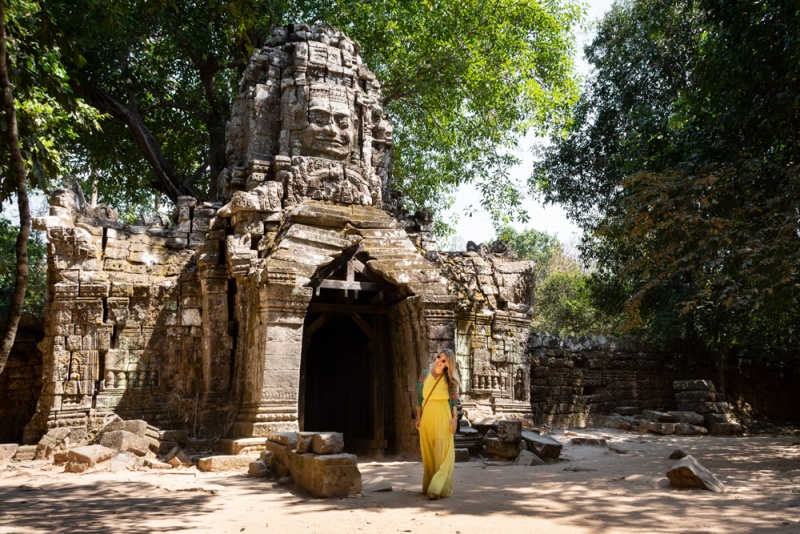
The Ta Som temple complex contains some of the most vibrantly colored, intricate stonework in the Angkor Complex. Bright green and red coloring add an interesting contrast to the grey stone structures. And you can really see how much detail was put into carving these amazing temples.
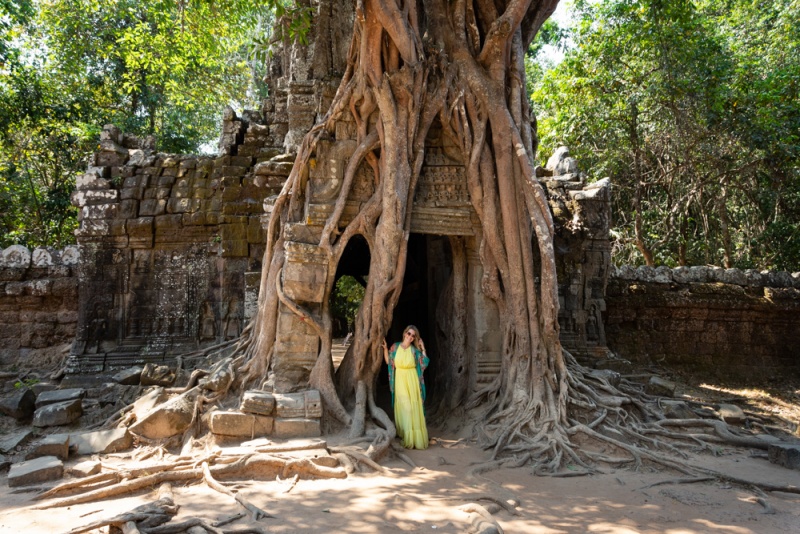
When you walk out of the back of Ta Som temple you’ll see several locals selling souvenirs here. Past them is an impressive gate with a large head standing watch from the top. Pass through the gate and look at it from the other side – it’s another example of the power of Mother Nature.
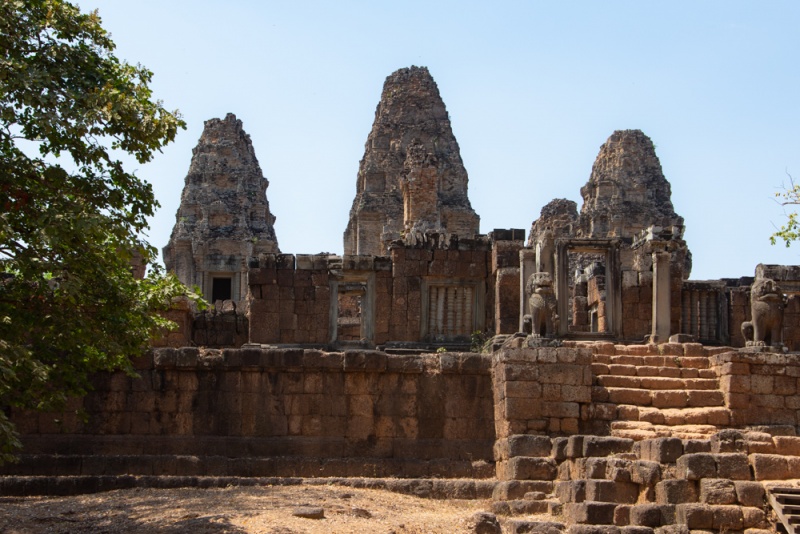
The East Mebon temple is quite similar to the Pre Rup temple (below), only with less stairs and no view. As you enter this temple you’ll pass through a small gate. Many tourists like to stop here as it is an ideal spot to see the temple in all of its glory. But be aware that this causes a bit of a traffic jam.
It won’t take long to see this small temple complex, 20 minutes should be plenty. There are some very nice women across the road selling fruit shakes and ice coffee if you find yourself here in the heat of the day and need some respite.
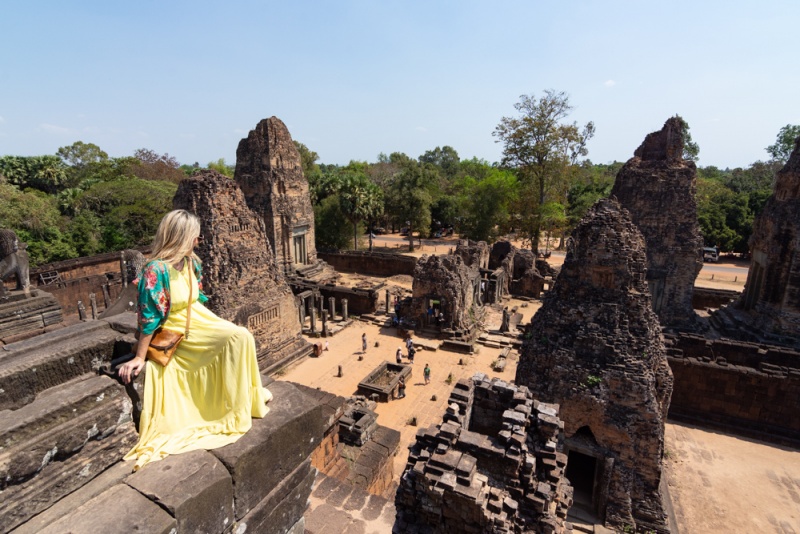
You’ll have to climb a set of very steep stairs to reach the top of the Pre Rup temple. The stairs are also very tall so it feels more like climbing a ladder. And with no handrails to speak of, this temple may be difficult for anyone with mobility issues or a fear of heights.
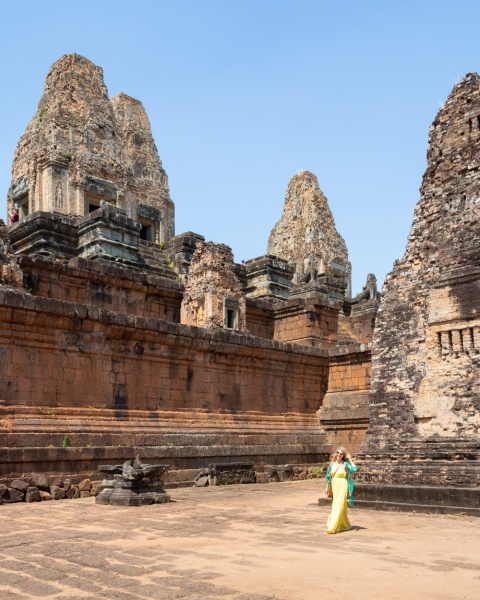
Once at the top, you’ll be rewarded with lovely views of the ruins below. There is one temple at the center, surrounded by four temples in the corners below, all in a similar pagoda style.
This temple is open early and stays open late so it’s a good option for sunrise and sunset if you are looking for an option other than the Angkor Wat temple.
Opening Hours: 5:00am – 7:00pm
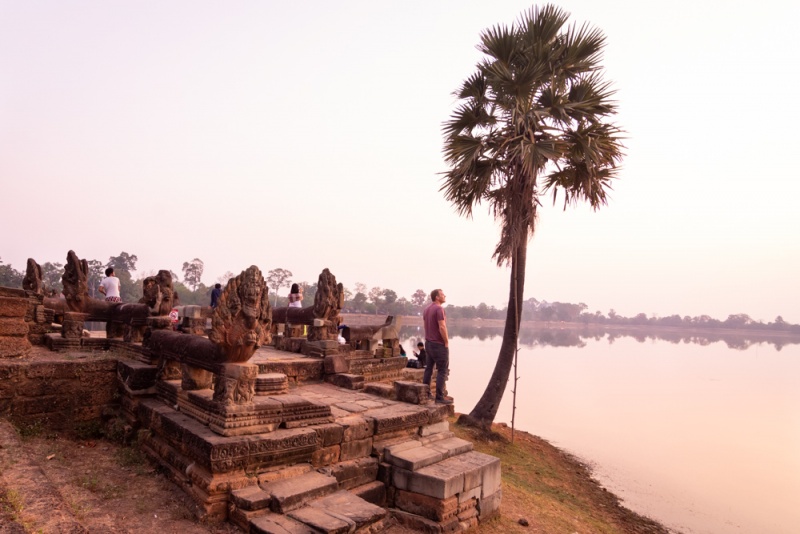
Srah Srang is technically part of the Small Circuit tour route , but you’ll also pass it at the end of the Grand Circuit. And you can probably convince your driver to make one last stop. The large man-made lake is a nice place to sit and relax before heading back to Siem Reap .
Some people choose to do the Grand Circuit in reverse order to try and avoid crowds at the temples. If this is your strategy, Srah Srang is a great place to watch sunrise away from the crowds of Angkor Wat. You’ll sit on the small stone platform at the west end of the lake and watch the sunrise across the water.
Opening Hours: 5:00am – 5:30pm
Enjoy the Grand Circuit Tour of Angkor Wat!
Want more information on the temples of Angkor? Check out our favorite guidebooks!
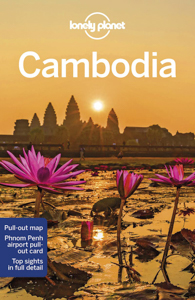
SHARE THIS ON PINTEREST
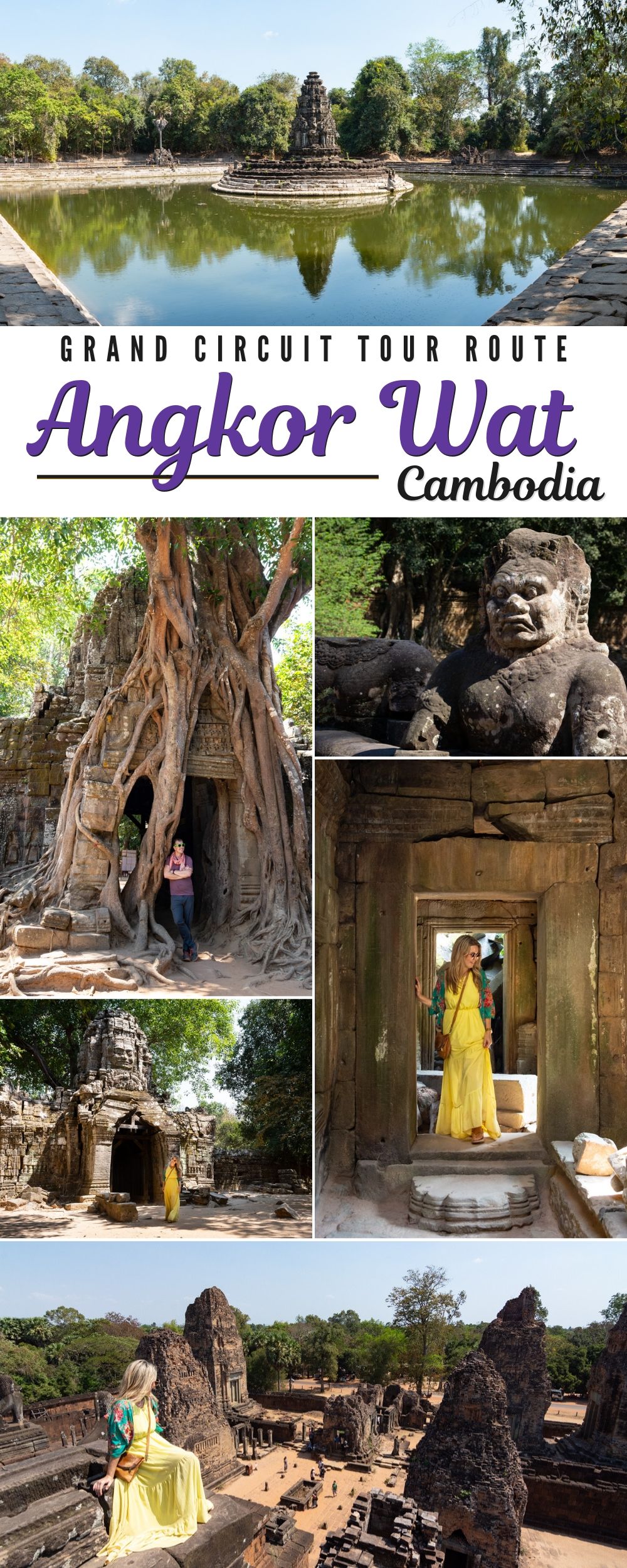
About the Author:

Val grew up in Portland, Oregon but moved to Oahu on a whim back in 2013. She sold her house and all of her belongings and bought a one-way ticket. Since then she’s taken two around-the-world trips and has visited 60-ish countries while living out of a duffel bag. Val started documenting the Wandering Wheatleys travels back in 2013 as a way to update friends and family about her whereabouts and to relay humorous daily interactions. The only readers were her mom and her mother-in-law but that didn’t stop her! These days you’ll find Val dreaming up future trips, creating new travel content, managing a team of amazing travel enthusiasts, and chasing around her two adorable but naughty kids.
View all posts
Related Posts
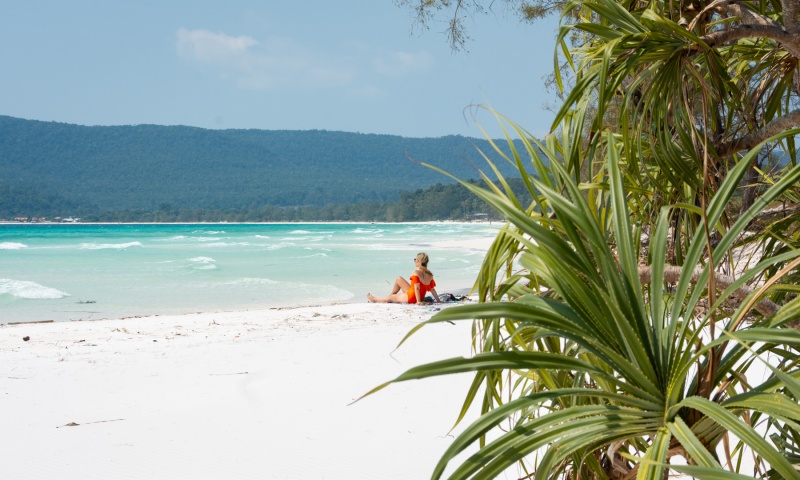
Koh Rong, Koh Rong Sanloem, or Koh Russey: Which Cambodian Island is the Best?
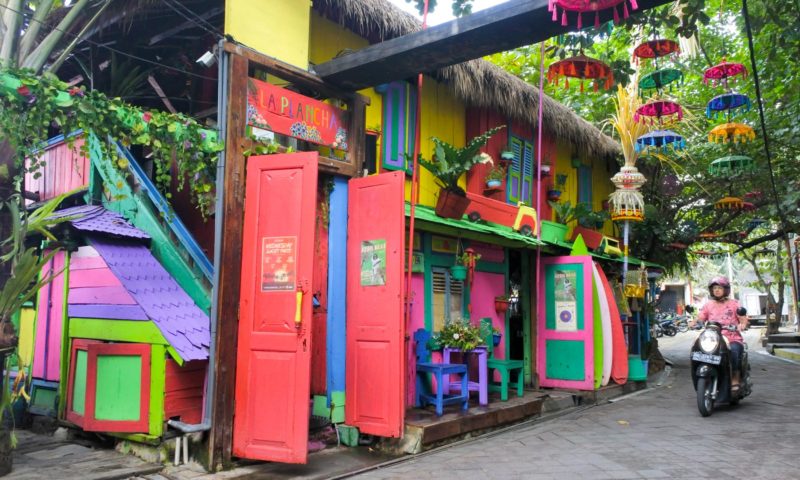
The 12 Best Luxury Hotels in Seminyak, Bali
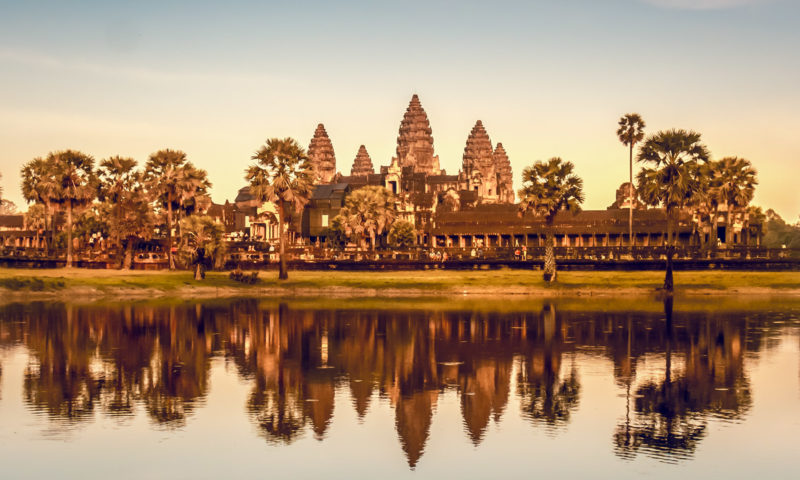
The 12 Best Boutique Hotels in Siem Reap
1 thought on “angkor wat: guide to the grand circuit tour”.
I used Nakry for my trip to Siem Reap and got his details via your blog. Thanks for that! He is awesome.
Leave a Comment Cancel Reply
Your email address will not be published. Required fields are marked *
Angkor Wat Itinerary: 4 Days In Siem Reap Cambodia
As a gateway to the famous Angkor Wat temples , Siem Reap is the cornerstone of Cambodia’s tourism and it’s definitely one of the best travel destinations to put on your Cambodia itinerary.
You could easily spend a week or two exploring everything in the Siem Reap area, but the top highlights can be seen with 3 or 4 days in Cambodia if you’re limited on time.
This Angkor Wat itinerary will guide you through some of the very best Angkor temples to see, along with a few of the most interesting sights in Siem Reap town itself.
Hopefully this gives you some ideas for what to do in Cambodia for 4 days!

✈ Where To Start
This entire Angkor Wat itinerary takes place in and near the small town of Siem Reap, Cambodia.
Fly to Siem Reap-Angkor International Airport (SAI), which is serviced by a bunch of budget friendly airlines with good ratings. Among other places, there are flights from Singapore (SIN), Bangkok (DMK), or Kuala Lumpur (KUL) to Siem Reap for as low as $40 USD.
You can shop for flights to Siem Reap at Skyscanner.
When you arrive in Siem Reap, take an airport transfer to your hotel. You can book this in advance on Klook for $11 by private car , or $5 by tuk tuk .
Check in to your hotel, and get rested up to explore some ancient temples for 4 days in Cambodia!
• Day 1: Angkor Wat Sunrise + Small Circuit
○ angkor wat sunrise.
Wake up early and start your Cambodia itinerary with the incredible Angkor Wat sunrise on the pond. Afterwards, explore the main temple area, which is huge.
○ Baksei Chamkrong
This is one of my favorite temples in Angkor. It’s a small, barely known pyramid temple near Angkor Thom. You might have to ask your driver to stop here, because most tours don’t include it in the normal itinerary. It’s a hidden gem!
○ Angkor Thom Gate
This is a gate on the south side of the Angkor Thom temple complex, right next to Baksei Chamkrong. It’s in poor shape, but you can still drive or walk through it, so it makes for some cool photo ops.
Bayon is one of the most important temples in Angkor Thom, and it has some of the best wall carvings in the area. This is also where you can see the famous stone faces that you’ve probably seen in lots of Cambodia photos.
○ Thommanon
This is one of the less known temples in Angkor Thom, and most tour groups don’t seem to go here. The carvings and doorways are good to explore.
Ta Prohm is the famous ‘Tomb Raider temple’ used in the 2001 Angelina Jolie movie. There’s an incredible tree here that is growing on top of one of the temples. It’s a must see.
○ Banteay Kdei
More incredible trees and temples! The tree roots at Banteay Kdei are absolutely massive, and they’re taking control of the buildings.

Angkor Wat Sunrise

Baksei Chamkrong Temple

Angkor Thom Gate

Bayon Temple

Thommanon Temple

Ta Prohm Temple

Banteay Kdei Temple

• Day 2: Angkor Wat Grand Circuit
○ preah khan.
Tour the Angkor Wat again (grand circuit this time), starting with Preah Khan. Most of the main temple is ruined, but it’s cool to see how nature is reclaiming what’s left of it.
○ Neak Pean
This is an island temple in the middle of a little pond. It looks better right after the rainy season. Late in the dry season there’s not much water left.
This is a smaller temple, but the best part is the stone doorway being consumed and held in place by a strangler tree.
○ East Mebon
This temple is not in great shape, but the highlight here would have to be the elephant statues in each corner of the temple.
This is a big temple near the end of the grand circuit. Funerals were done here, so that may be why the temple looks so creepy. The buildings at the top of the pyramid are in the best shape, so be sure to take a look up there.
○ Bantei Srei Temple
This temple is a 1 hour drive from Siem Reap, but it can be combined with a grand/small circuit tour if you pay your driver a bit extra. The red sandstone colors are nice, and it’s known for having some of the best stone carvings out of all the Khmer temples.

Bantei Srei Temple
• Day 3: Day Trip To Koh Ker Temples & More
○ koh ker temple.
Hire a driver for the day and head over to Koh Ker, a group of remote temples about 2.5 hours drive from Siem Reap. The main building is a 7-tier pyramid in the forest, and a stairway leads to the top where you can get a nice view of the whole area.
○ Prasat Pram Temple
This is an incredible spot that’s part of the Koh Ker area. These are ancient temples being swallowed up by huge strangler trees and you must see them while you’re nearby.
○ Beng Mealea
This is another remote temple you can visit on the way back to Siem Reap. The temple is mostly ruined, but that’s part of what makes it cool!
○ Roluos Group
Last but not least, you’ll find the Roluos temples just 30 minutes east of Siem Reap. These date back to the 9th century, making them some of the oldest Khmer temples in Cambodia (you may have to pay your driver a little extra to pack so many sights into a 4 day Cambodia itinerary like this, but it’s worth it).

Koh Ker Temple

Prasat Pram Temple

Beng Mealea

Roluos Temples
• Day 4: Siem Reap Town
○ bugs cafe.
Start out Day 4 by exploring the many interesting restaurants and shops in Siem Reap town. If you really want a unique experience, head over to the Bugs Cafe. This place serves fried tarantulas, scorpions, and other bugs to eat! It was started by a French expat and a Khmer chef, and it’s a fusion of local culture as well as the influx of tourism.
○ Wat Thmey (Killing Fields)
Make a culture & history stop at Wat Thmey, a Cambodian temple that’s also notable for being used as a killing field during the Khmer Rouge communist rule in Cambodia during the 1970s. There is a stupa memorial filled with skulls and bones from the victims of the genocide.
○ Siem Reap Market
The riverside markets in Siem Reap are great for souvenir shopping, street food, and street photography. The stalls have all kinds of items for sale, from paintings and clothing, to fridge magnets and postcards.

The Bugs Cafe

Wat Thmey Temple

Siem Reap Market
More Angkor Wat Travel Tips
I hope this Angkor Wat itinerary was helpful for planning your own Cambodia trip.
These are just a few ideas of what to do in Cambodia for 4 days. You could easily spend longer in Siem Reap exploring all of the nearby temples, and enjoying the restaurants and markets.
Don’t forget to check out my full Angkor Wat Travel Guide with free tips, maps, photos, and more!
Best Angkor Wat Tours
If you're looking for a good Siem Reap driver/guide to show you around, Klook has shared day tours starting from $12 USD .
If you plan to do the sunrise tour, which I highly recommend, they also have a private Angkor Wat sunrise tour by tuk-tuk for $19 USD or a shared sunrise tour for $12 USD .
We've used Klook for lots of tours and activities around the world, and they're great! Highly recommended.
Book Now: Angkor Wat Shared Tour / Private Tour

Where We Stayed
We stayed at the 4-star La Residence Blanc D'Angkor in Siem Reap . It was $18 USD per night for a clean double room with cold A/C, work desk, refrigerator, wardrobe, and more. There's also an on-site restaurant and pool.
The staff there is amazingly friendly, and I love the epic wall art showing scenes from the Angkor Wat. It sets the mood for exploring some Cambodian temple ruins.
Prices may fluctuate from time to time, so just keep an eye out for a good deal.

We stayed at this 4-star hotel in Siem Reap for $18 USD

This was the pool at our hotel
- Angkor Wat Cambodia Temple Guide & How To Visit
- Cambodia Travel Guide: Tips, Photos, & Blog
You may also like
How to visit dhigurah island: budget paradise in maldives, how to visit tanjung puting national park in indonesia, sanur bali travel guide: 23 best things to do, coron vs el nido: which is better all differences explained, banggai islands travel guide & itinerary for sulawesi, paisu pok lake in banggai: bluest lake in indonesia.
The photography in this post is stunning! You’ve really managed to capture Cambodia’s beauty well. I love this itinerary, some really great suggestions in here for me to visit next time!
Leave a Comment Cancel Reply
Save my name, email, and website in this browser for the next time I comment.

Visiting Angkor Wat – The Ultimate Guide
Posted on Last updated: January 29, 2024
Categories Asia , Cambodia , Guides , Travel Guides
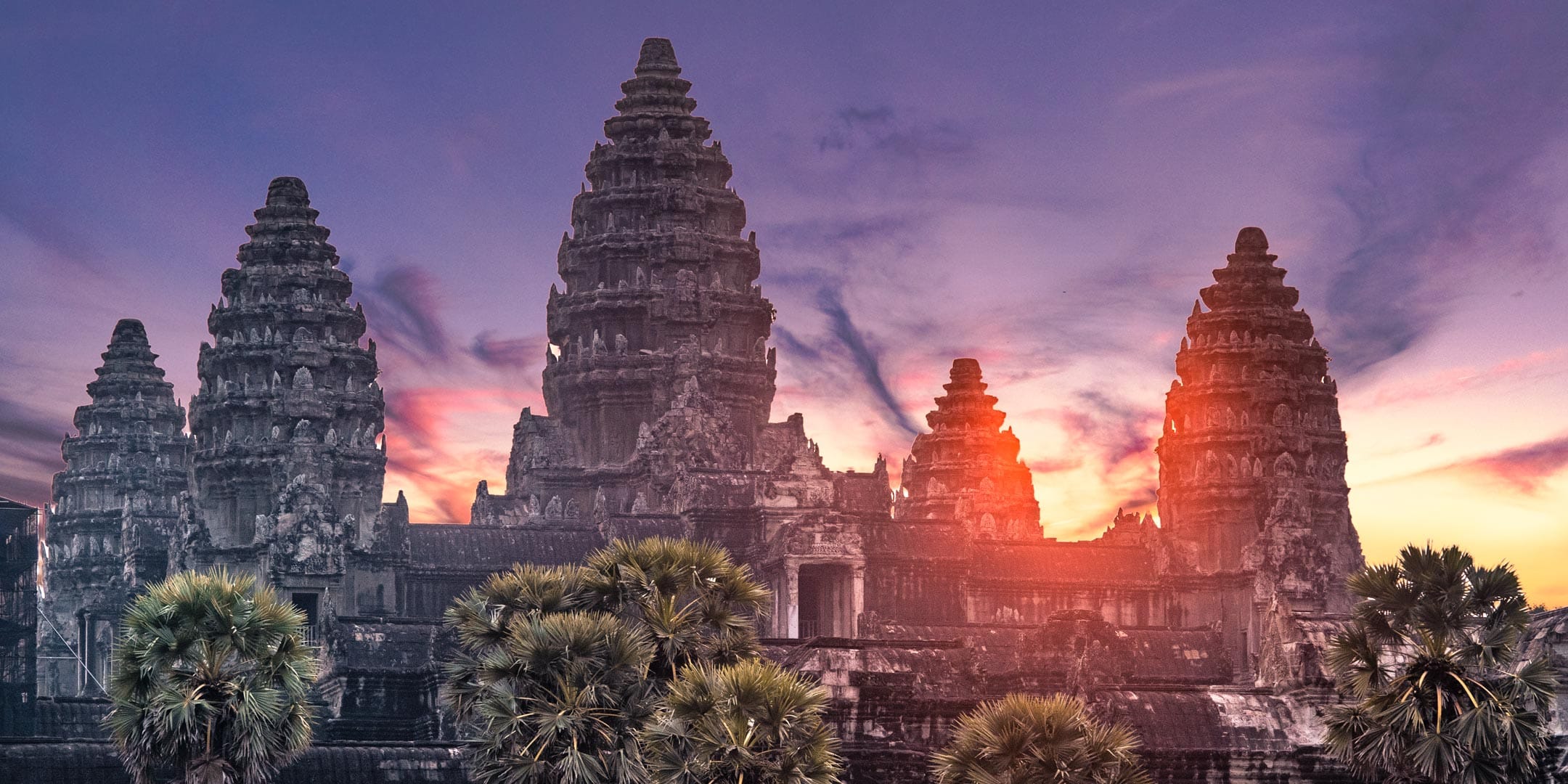
Visiting Angkor Wat is not hard. Being one of the most popular tourist attractions in Asia and the biggest highlight of Cambodia, the ancient Khmer city hosts millions of tourists every year.
Visiting Angkor Wat the best way possible and having a wonderful time – well, this is not as easy as it sounds. Avoiding hordes of tourists, surviving Cambodia’s scorching heat, and finding the best route around the dozens of temples can leave you physically and emotionally exhausted. Visiting Angkor really is a daunting task.
It is possible, though, to see one of the biggest marvels in the world, have a great time, and even avoid the gazillion other enthusiasts. No, I’m not advertising some group tours here ( I hate those ). If you plan your visit carefully ( and I guess you’re already doing that since you’re reading that post ), you can be prepared for everything Cambodia has to throw at you. And if you follow my itinerary, you can even avoid the massive crowds ( not all of them but at least the huge groups ) and see Angkor Wat the best way possible.
Now I know what you’re thinking: Is it really necessary to read such a long guide only to visit a temple? Angkor Wat does look big, but is it really that hard to see? Well, Angkor Wat is significant indeed, but that’s not the main reason you need a guide. Believe it or not, to see Angkor Wat the best way possible, you need not one but three days. How come? Because Angkor is not just a temple.
What is Angkor Wat
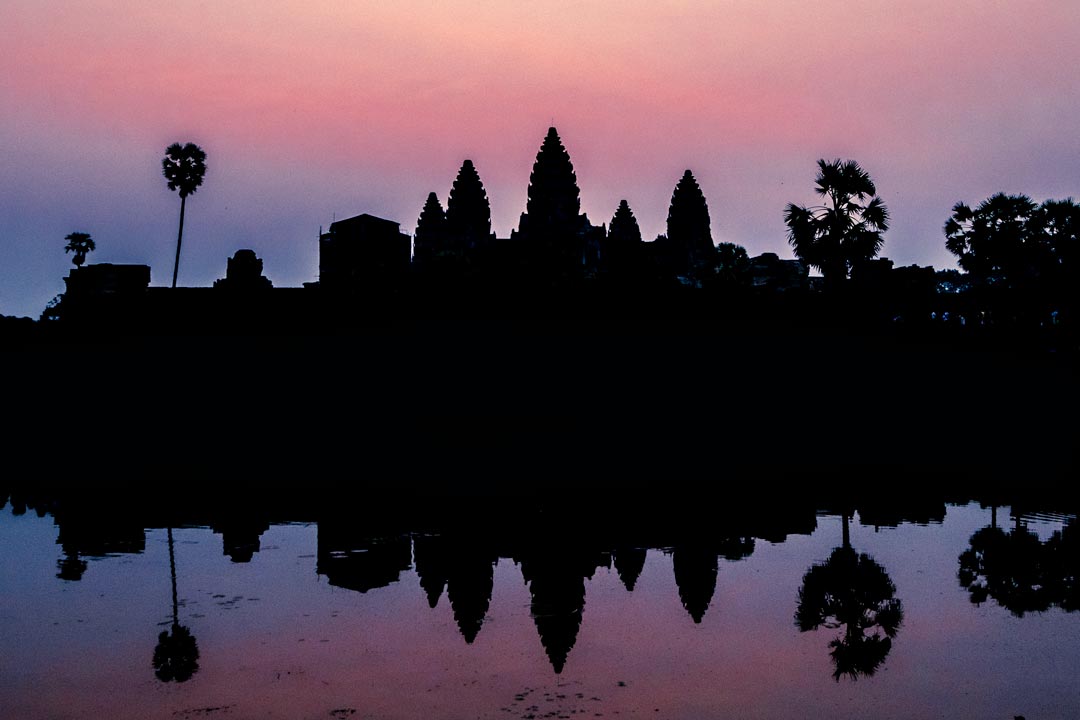
Wait, I thought Angor Wat is this colossal temple that’s on the flag on Cambodia. What do you mean, it’s not a temple?
Well yes, this is Angkor Wat, but it’s only one of the many temples in the Angkor Archeological Complex. A building complex containing more stone than the great pyramid of Giza and covering four times more land than Vatican city. The forgotten medieval metropolis used to be home to more than 1,000,000 people, and it’s considered to be the largest preindustrial city before the Khmers abandoned it.
We can see only a glimmer of the glorious site today. The reason is that apart from public infrastructure and temples, all other buildings were built by wood, which was fastly consumed by the merciless Cambodian jungle. Due to many wars and political instability, most of the city remained hidden in the wilderness until it was rediscovered in 2007.
The main temple – Angkor Wat – may be the largest religious structure on Earth and the biggest highlight of the park, but it is more definitely not the only thing to see there.
Getting to Angkor Wat
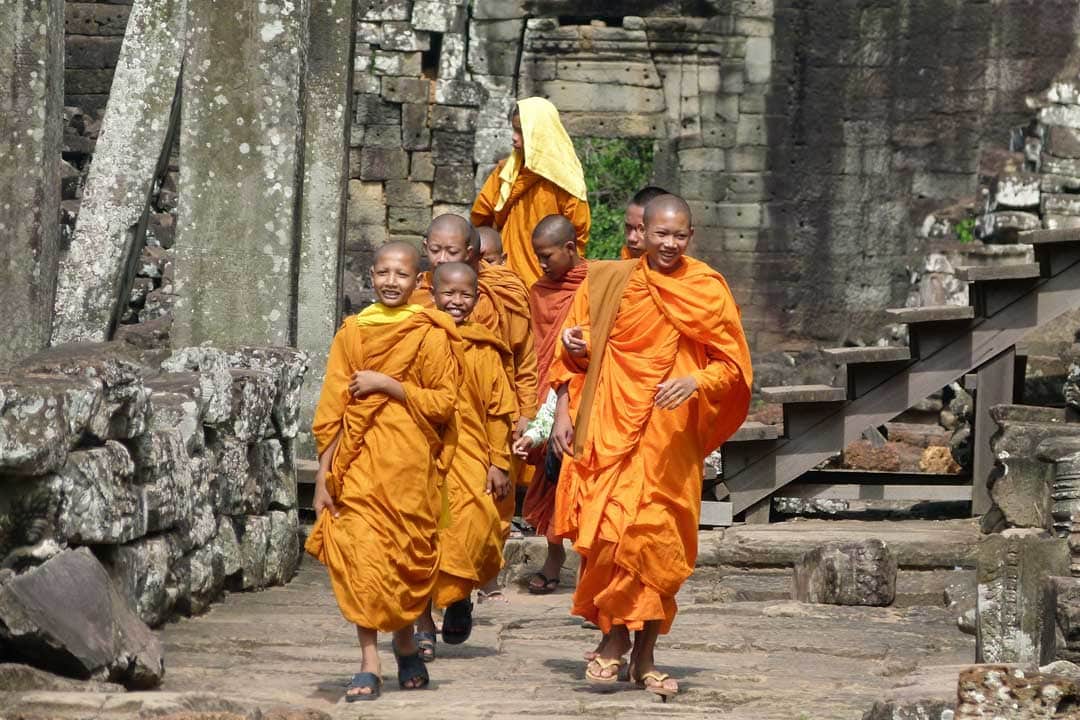
Getting to Angkor Wat is the easiest part of the whole adventure. Being an immensely popular travel destination, everything around the archeological complex is built for tourists.
The gateway to the temples is the Cambodian city of Siem Reap. It has a modern airport, plenty of hotels, and food joints ( including a vast choice of western food ). If you prefer to travel by bus, Siem Reap has more bus routes to it than any other place in Cambodia.
If you still haven’t got your Angkor Wat journey set, check out 12go.asia . The unrivaled number one transport site in Asia.
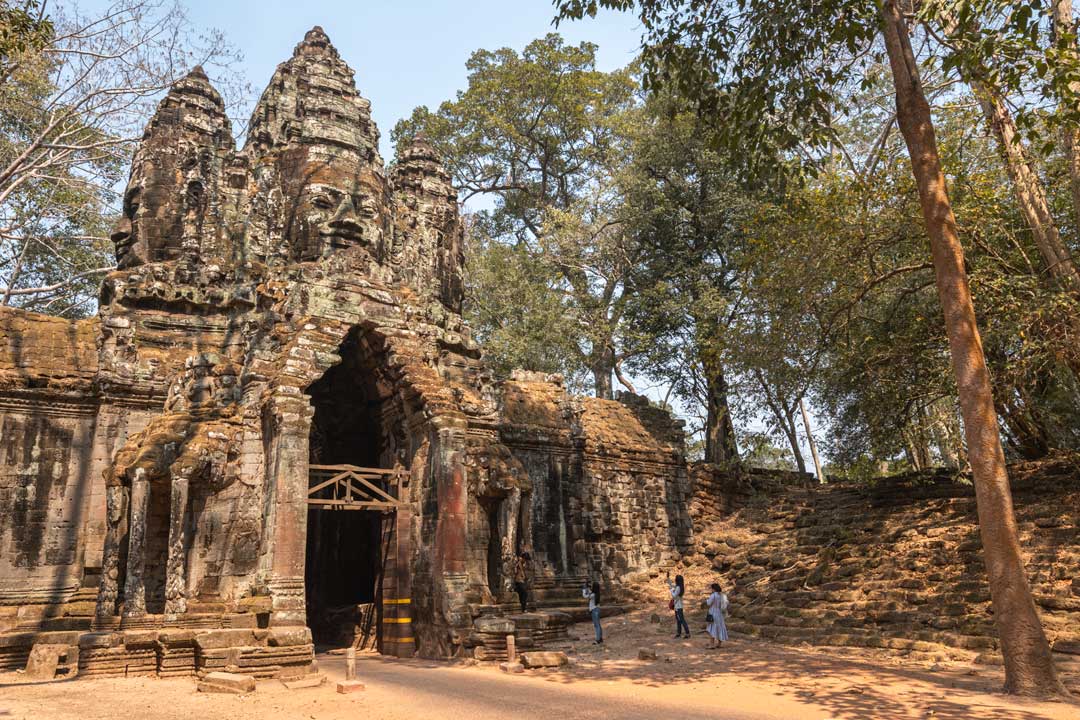
The Angkor Wat archeological complex is located around 5km ( 3 miles ) from Siem Reap, and you can’t reach it by foot ( I mean you can, but it would be very unpleasant and would waste a ton of time ). You can hire a bike which I wouldn’t recommend unless you’re a big bike enthusiast ( distances between the temples are significant, and Cambodia is hot and dusty ) or hire a tuk-tuk driver.
Tuk-tuks are the most popular way to explore the Angkor temples. They cost around 20-30 USD per day and can be found everywhere in Siem Reap. Keep reading to see how to get yourself a top-notch tuk-tuk driver.
Where to Stay in Siem Reap
Central Blanche Residence
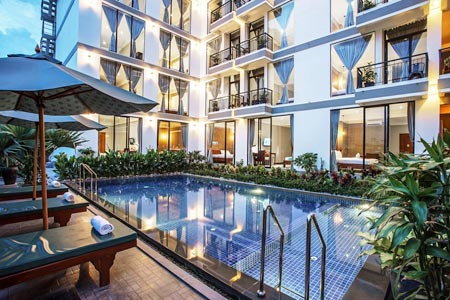
An incredible value for money, the Blanche residence offers modern, clean rooms, and friendly staff that goes above and beyond to satisfy your every need. Airport shuttle and breakfast are also included in the price. Also, a great pool area which is vital to surviving the scorching heats of Cambodia! See the latest prices
Want to explore more options in Siem Reap? See the best hotels in town with a tasty breakfast and free wi-fi
What’s Inside the Angkor Complex
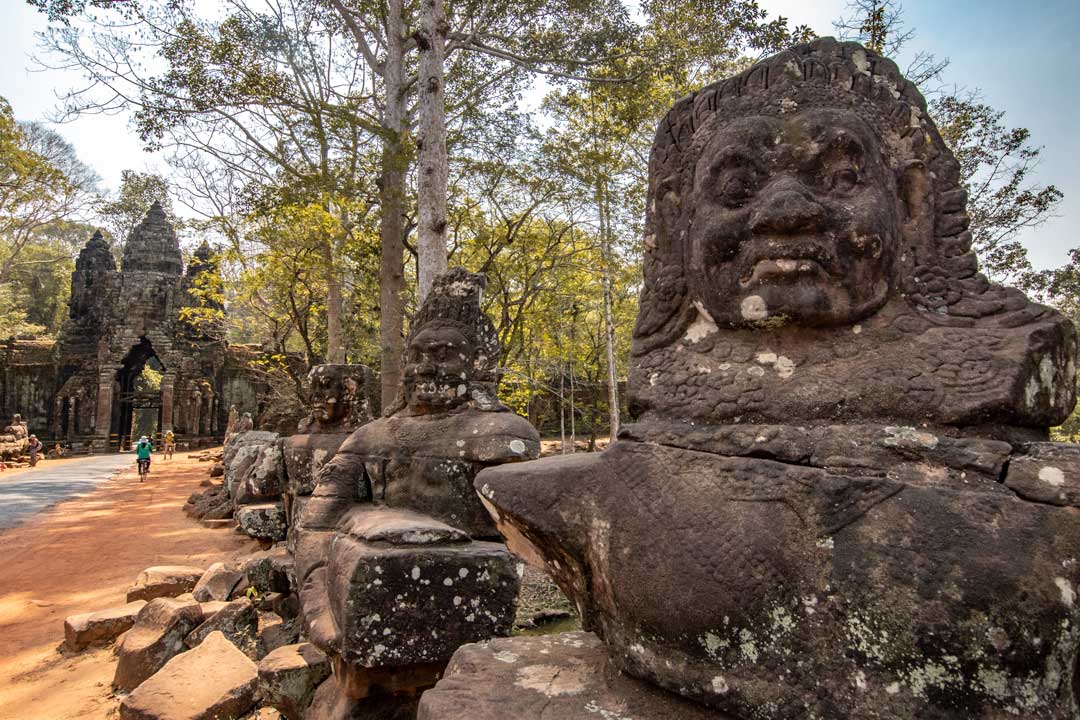
There are around 50 temples inside the Angkor Wat complex, but very few people attempt to see them all. Since some of them are not in perfect condition while others have kind of a similar design, there’s no need to do it. Here are the must-see temples I recommend checking out when visiting Angkor Wat.
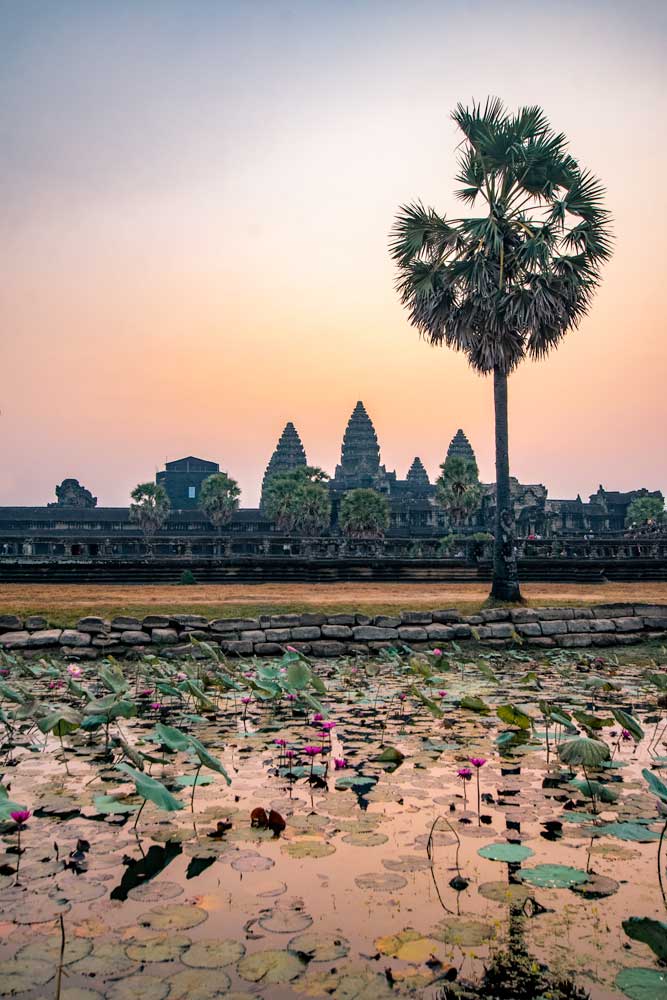
No surprise here. The biggest reason for your Angkor visit is to see the main temple, of course. Built in the 12th century and rediscovered for the world in 1860, Angkor Wat is the largest religious structure on Earth. It’s the symbol of Cambodia and ( probably ) the most recognizable monument in Asia.
Angkor Thom
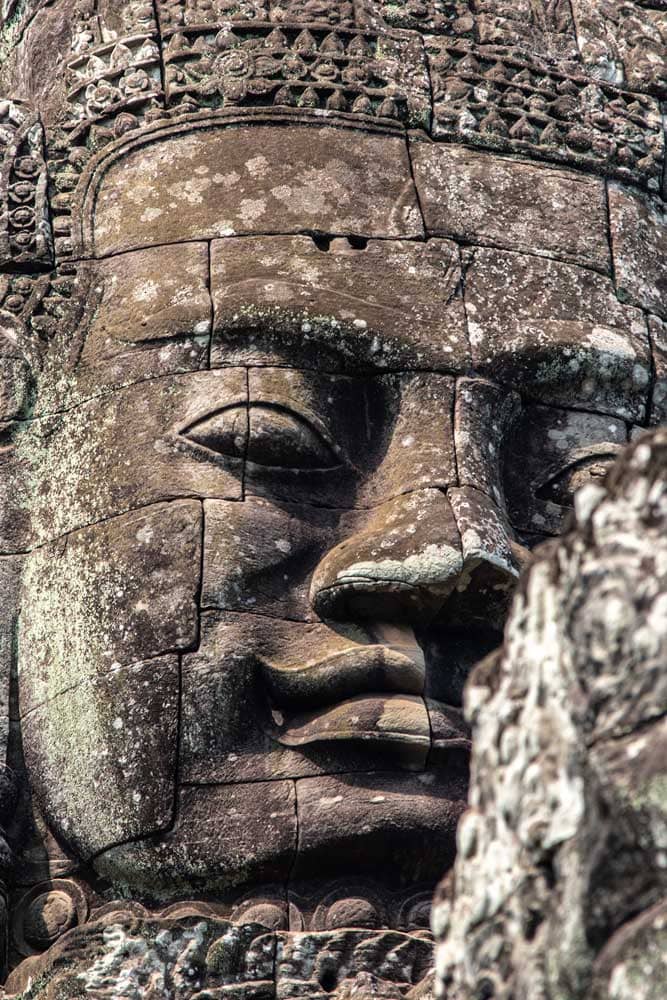
The second most famous sight in the complex, Angkor Thom, is not just another Khmer temple. Angkor Thom is a whole city with its own sanctuaries, gates, terraces, streets, and everything! It was the last great capital city of the Khmer Empire, and it’s absolutely glorious.
If there is only one thing to see in Angkor Thom, it’s the main city temple – Bayon. Decorated with 54 gigantic smiling faces, the temple is one of the most enchanting places on the planet.
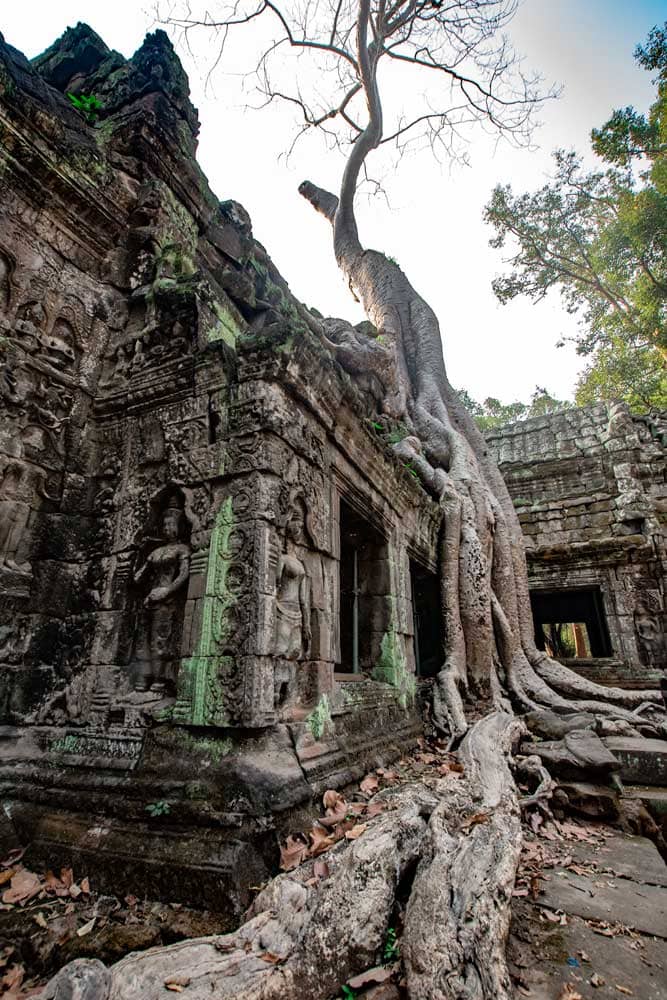
The last of the big three, Ta Prohm is known as the “Tomb Raider Temple”. Once the Angelina Jolie movie hit the cinemas, Ta Prhom became a superstar overnight and is now one of the most visited spots in Cambodia.
The magic of Ta Prohm, however, has nothing to do with the movie. Once abandoned ( around the 15th century ), the jungle quickly consumed the temple. The Silk-cotton and Strangler fig trees made the ruins their new home, creating an incredibly picturesque blend between nature and mankind.

A vast temple that used to be home to 100,000 people, Preah Khan is one of the most underrated highlights in the complex. Visiting Angkor Wat and skipping it is a mistake plenty of tourists do. I’m sure you won’t be one of them.
It’s divided into four enclosures, and all of them are full of beautiful bas-relief carvings. To get there, you need to pass through one of the famous moat bridges that depict a battle between mythical Garudas and the King of Nagas.
Banteay Kdei
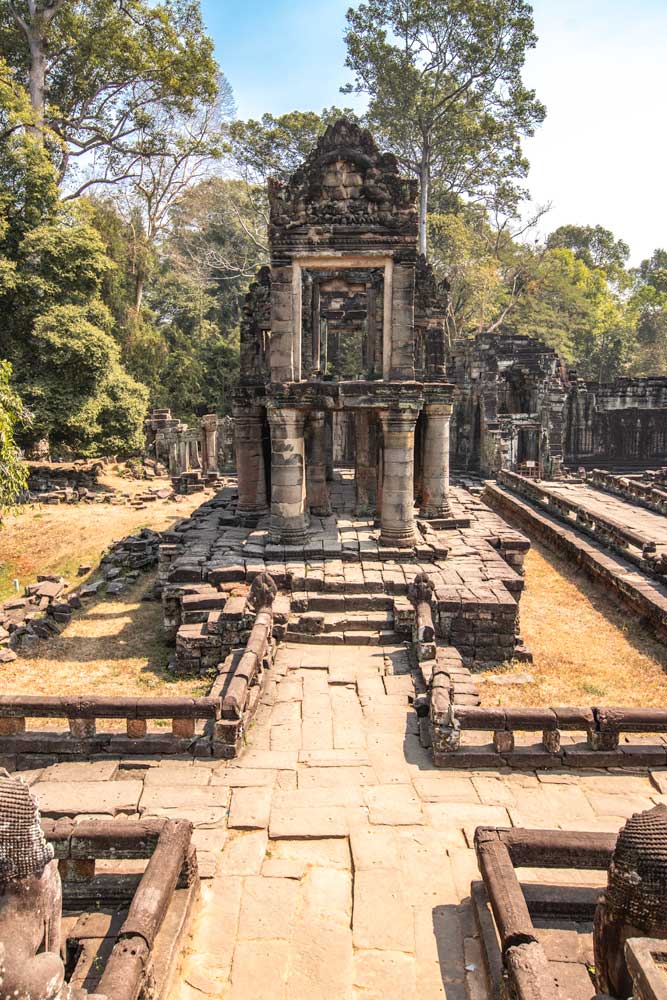
The “Citadel of Chambers” is another hidden gem of Angkor Wat. It’s a labyrinth rich in bas-relief carvings depicting mythical beasts and legends. It’s not on the main path of the tours, so unlike the other temples, you won’t have to battle the tourist hordes to enjoy this sanctuary.
Psst : Wanna know more about the five temples above and see some cool photos? Check out my Top 10 Siem Reap Temples post, and you’ll also learn which are the other five I recommend visiting.
The Best Way to See Angkor Wat
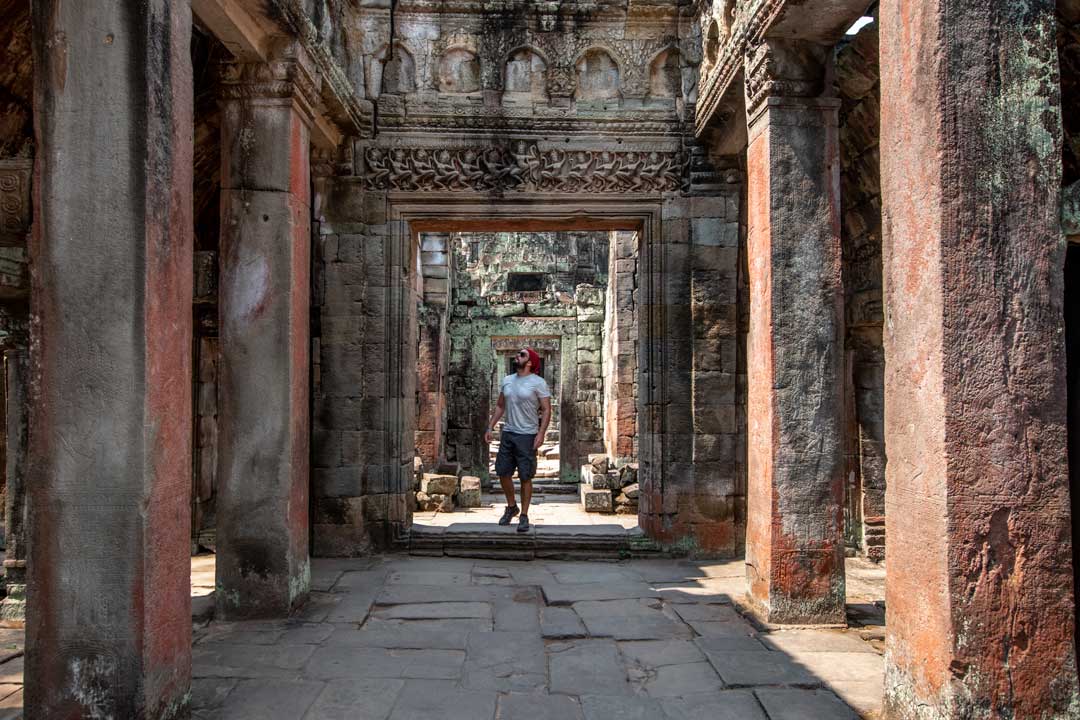
The best way to see Angkor Wat would not lead you around all 50 temples. I mean, if you’re a huge history buff, you can get the 7-day pass and try to do it, but for the regular visitor, so many temples would be too much. I suggest visiting around ten temples in 3 days.
Once you have a tuk-tuk driver, they would offer you three different routes – Small Circle (Angkor Wat, Angkor Thom, Ta Keo and Ta Prohm), Big Circle (Preah Khan, Neak Pean, Ta Som and Pre Rup) and the Long Trip ( Women’s Temple , Landmine Museum and other small temples outside the main park).
For your three days, my best suggestion is skipping the Long Trip and focus on the other two. To escape the crowds and have the best experience possible, we’re going to tweak them a little bit.

If you arrive at Siem Reap at noon – afternoon, Get your ticker at 4:30 – 5:00 PM. Once you have it, go inside the park. Make sure it’s after 5:00 PM though. This late of a visit won’t cost you one of the ticket pass days, and you can watch the sunset for free.
The most famous sunset point in Angkor Wat is the Phnom Bakheng temple. However, the temple only allows 300 people on it, and arriving that late almost guarantees you won’t be able to get in. My recommendation is to go for sunrise over the Srah Srang reservoir.
Best Way to See Angkor Wat – Day 1
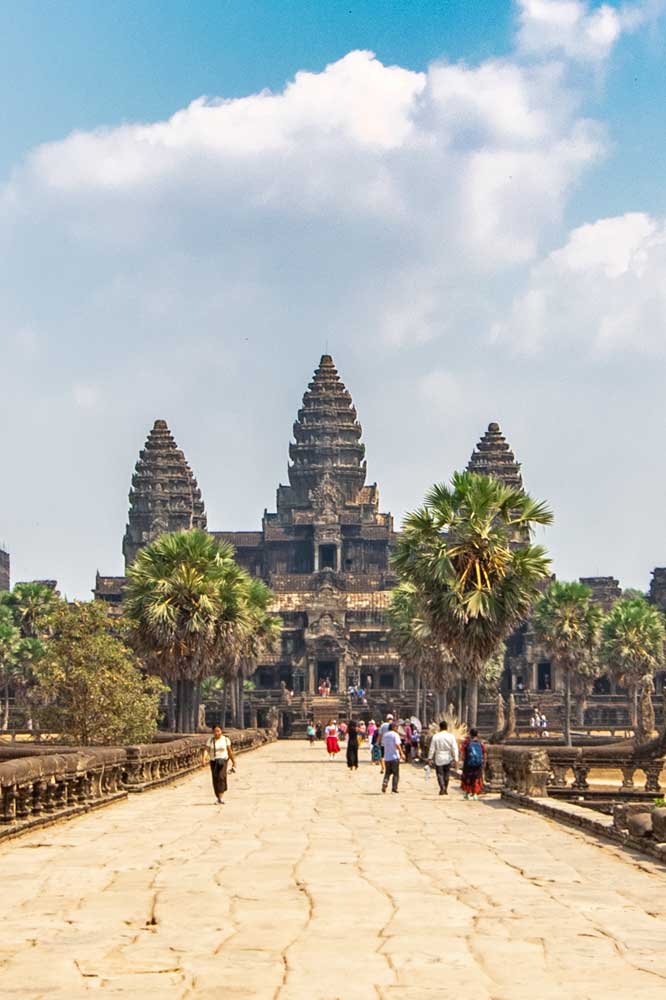
Surprisingly, our first day would start late. Tell your driver to wait for you around 11:00 – 11:30 AM and head straight to Angkor Wat. Note: If you didn’t manage to get your ticket the previous day, your first stop would be the ticket office. Being the main temple, Angkor Wat is impossible to catch free of people, but around noon is your best bet. The first groups are there right after sunrise, while the lazy ones arrive around 10:00 AM. Don’t worry about the sun. It would be hot, but Angkor Wat is mainly covered so you won’t be that bothered.
After lunch, continue to Angkor Thom. The biggest must-see there is the Bayon Temple.
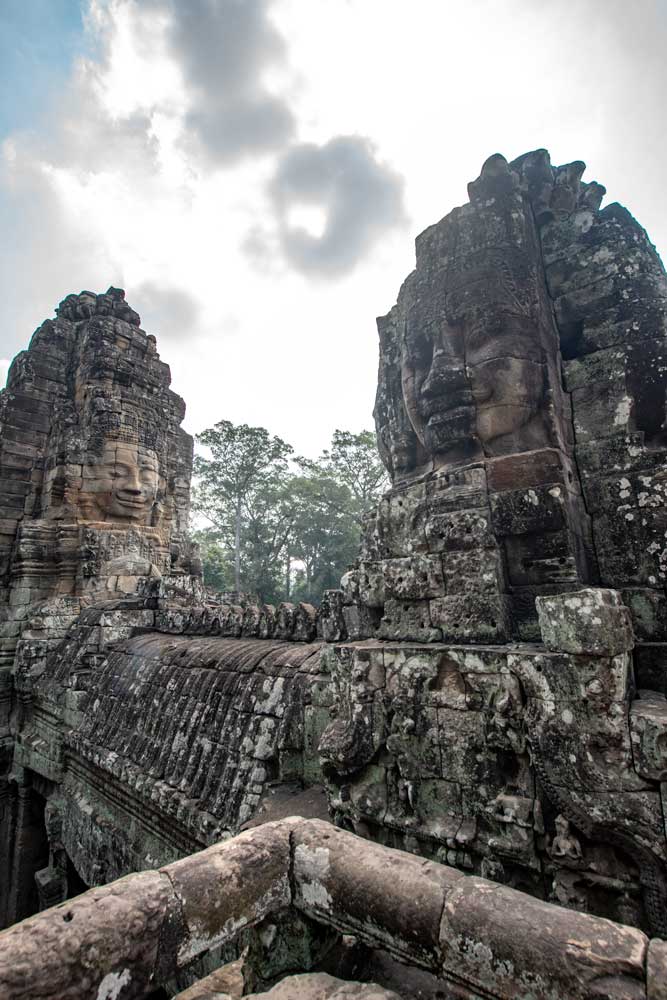
Exploring the two main temples of Angkor should take the better part of the day. If you still have some power left, in the afternoon, you can take a look at the other attractions of Angkor Thom. The Elephant and Leper King terraces are a sight to be seen, while the smaller temples – Baphuon and Phimeanakas – would offer a fascinating non-crowded experience.
Best Way to See Angkor Wat – Day 2
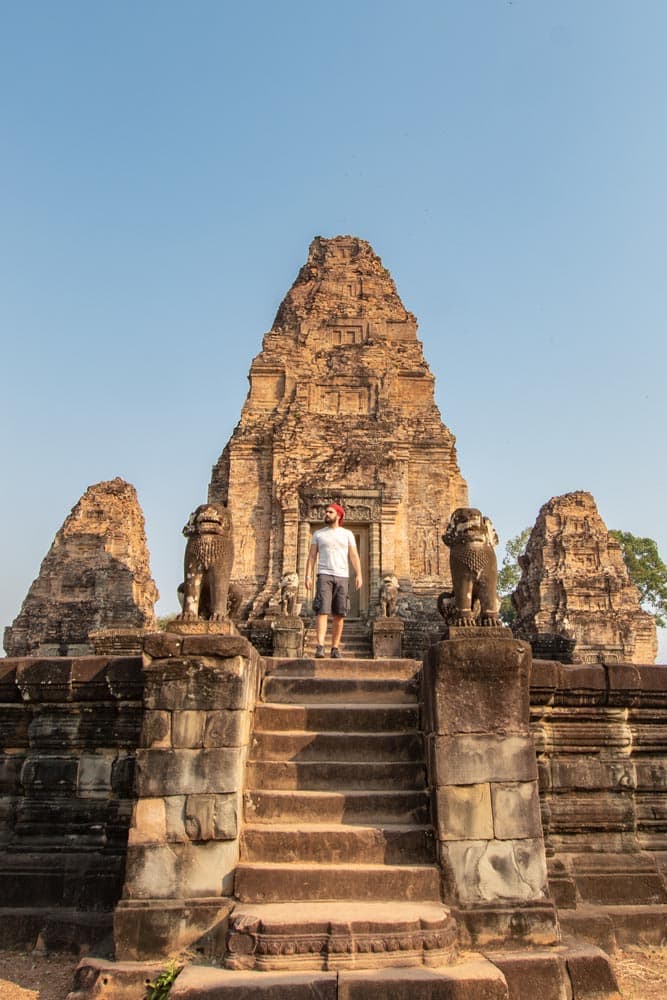
Our second day will start a lot earlier. We’re doing a modified Big Circle today, but to avoid the groups with the same idea, we’ll have to lose some sleep.
Start your trip around 6:30 AM so you can reach the first temple – Pre Rup – before 7:00 AM (groups will arrive around 8:00 – 9:00 AM). Pre Rup is one of the few temples that opens before 7:30 AM, so it’s the perfect place to start your day.
At 7:30 AM, you should be at the second temple – East Mebon. Those two temples may not be as grand as the ones from day one, but they quite different and have their charm.
The third sanctuary for the day is Ta Som. This is the first jungle-consumed temple you’ll visit. Make sure to go to the far end of it to get a picture with the fig tree that hugs the old gate. Ta Som is relatively free of people before 9:00 AM.

Your driver would probably suggest a visit to Neak Pean next, but my advice is to skip it. It’s quite a boring one and will only slow you down. Go straight to the last temple of the day – Preah Khan.
If it’s still early in the morning, there should be no groups hording around. Preah Khan is huge and would easily take you a few hours to explore. Once you get enough ruins for the day ( or the sun becomes too much ), it’s time to go back to Siem Reap and relax. Visiting Angkor Wat sure isn’t an easy task.
On the way back, instruct your driver to go through the North Gate. It’s a very picturesque place, and you won’t be sorry.
Best Way to See Angkor Wat – Day 3
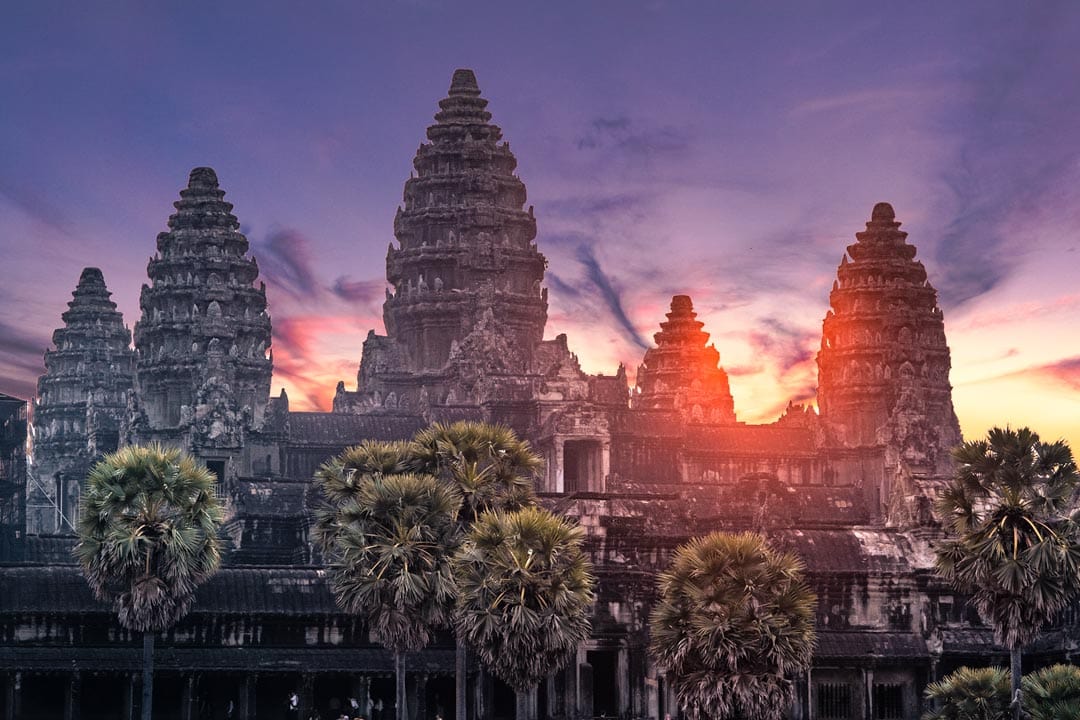
The last day of our Angkor Wat visit will start early. Veeery early. It’s time to witness the most famous sunrise in the world!
If you want to get a good photo, you need to go even extra earlier. Arrange your tuk-tuk for 4:30 AM ( yup, you’ve read that right ) and make sure at 5:00 AM ( when the temple opens ), you are among the first ones to enter. It may sound excessive, but if you want to get a good photo spot, this is the only way. The actual sunrise starts around 6:30 AM, so if you don’t care about the photo, but you’re more into the experience – go an hour later.
Around 7:00 AM, the hordes gathered for the sunrise would either go inside Angkor Wat or go back to the hotel for breakfast. Well, we’ve already seen Angkor Wat, so we make our way to another heavyweight attraction – Ta Prohm.
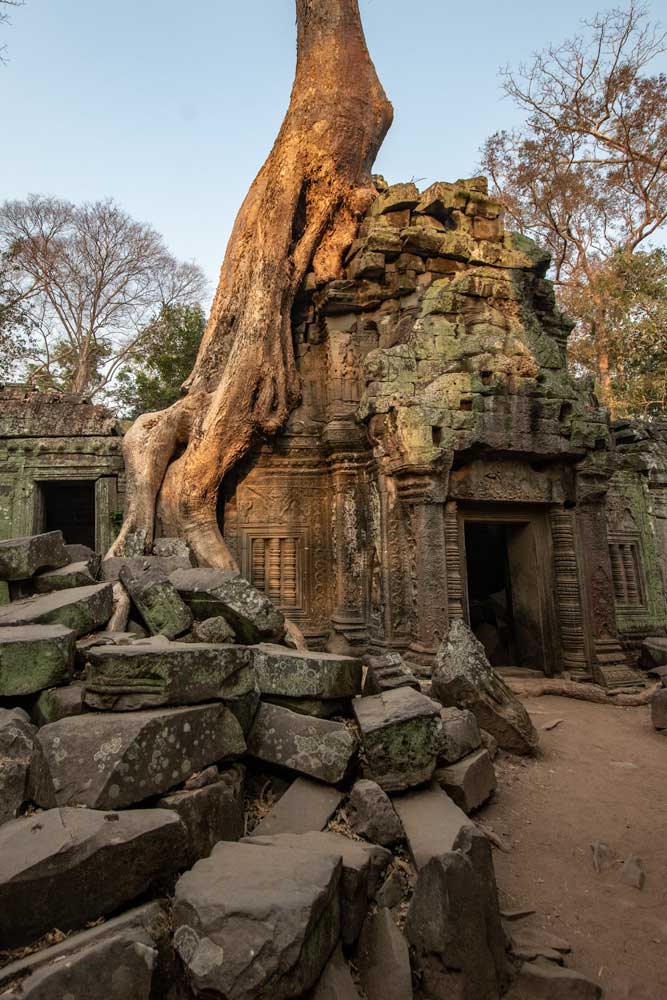
The only time of the day you can catch the Tomb Raider Temple relatively free of people is at its opening times – 7:30 AM. There are several enormous fig trees around the temple, take your time, and see them all. There’s also a very curious attraction named the Dinosaur of Ta Prohm . There is no map, so challenge yourself to find it. Take your time exploring around. This is the last tourist-heavy temple on our visit, so we’re no longer in a hurry.
Our day continues is the underrated Banteay Kdei. No matter the time you make it there, there shouldn’t be a lot of people, so you can enjoy the fantastic bas-relief carvings in peace.
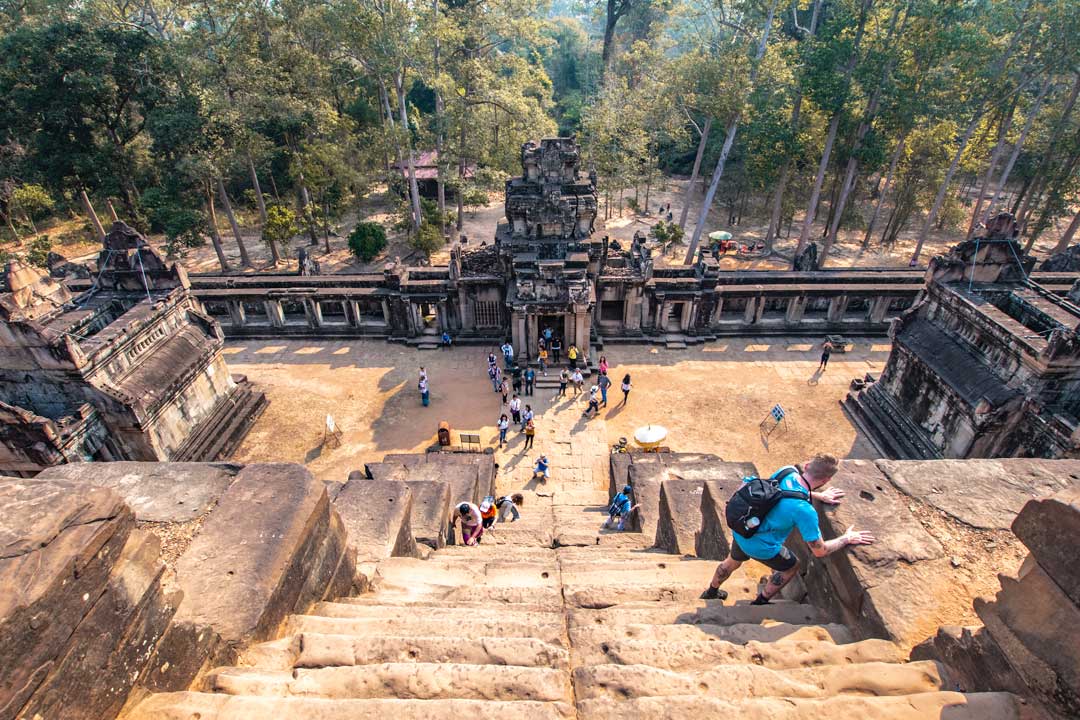
Once you get enough of them, make your way to Ta Keo. This pyramid-shaped temple is not that spectacular, but the climb up ( and down ) makes it an exciting challenge. The top of the pyramid is also a pretty good photo spot, so it’s worth a visit. Other tourists won’t ruin the experience, but there is no shade at this temple, so I wouldn’t recommend a visit at noon.
The last attractions on our Angkor Wat visit are two small temples right next to each other. There’s plenty of shade around Spean Thommanon and Chau Say Tevoda, plus some street vendors selling fruits and drinks. What better place for a picnic and kick-back time.
Your way back to Siem Reap goes through Angkor Thom, so if there’s something you missed on day one, you may stop and check it out now.
Angkor Wat Sunrise
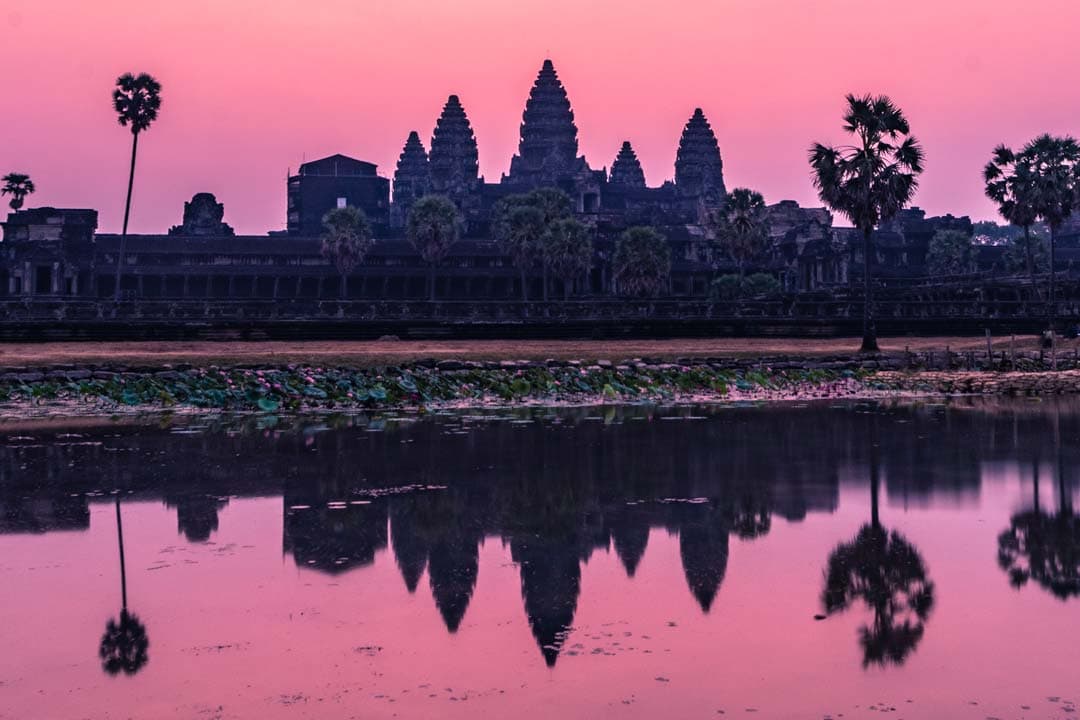
Visiting Angkor Wat is not complete without experiencing the sunrise over the main temple. Let me warn you though, it may sound as a serene activity, but in reality, it is everything but that. Especially if you want to get a good photo.
I like to call Angkor Wat sunrise ‘the most popular sunrise in the world’. There are plenty of places I’ve explored at dawn, but I’ve never witnessed so many people trying to capture the flaming ball of gas. It may be a bit overcrowded, but it’s a definite bucket list experience . And since you’re already in Angkor Wat, it would be a shame to miss it just because you hate getting up early.
Psst: it’s me again! I have another post explaining in detail what to do to have the best Angkor Wat sunrise experience . Check it out!
Some Tuk-tuk Advice
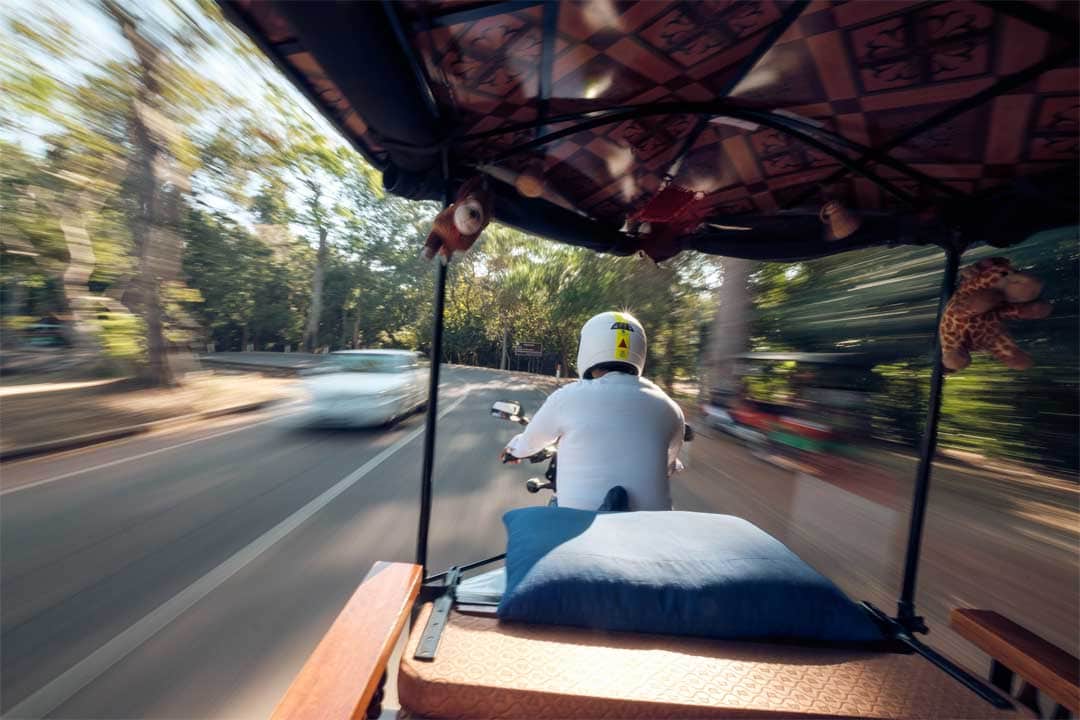
Finding a tuk-tuk driver in Siem Reap is the easiest thing in the world. They would start offering their services at the airport. They would be waiting in front of your hotel. Your hotel would offer you some too. And if you still haven’t got one, just seeing you walking around Siem Reap would attract them like flies. But how to make sure you get an excellent tuk-tuk driver? The answer is – you prepare your transport before you even arrive.
A tuk-tuk driver named Mr.Sok was highly recommended to me, so I gave it a try. Unfortunately, he was already booked, so he arranged one of his friends to show us around.
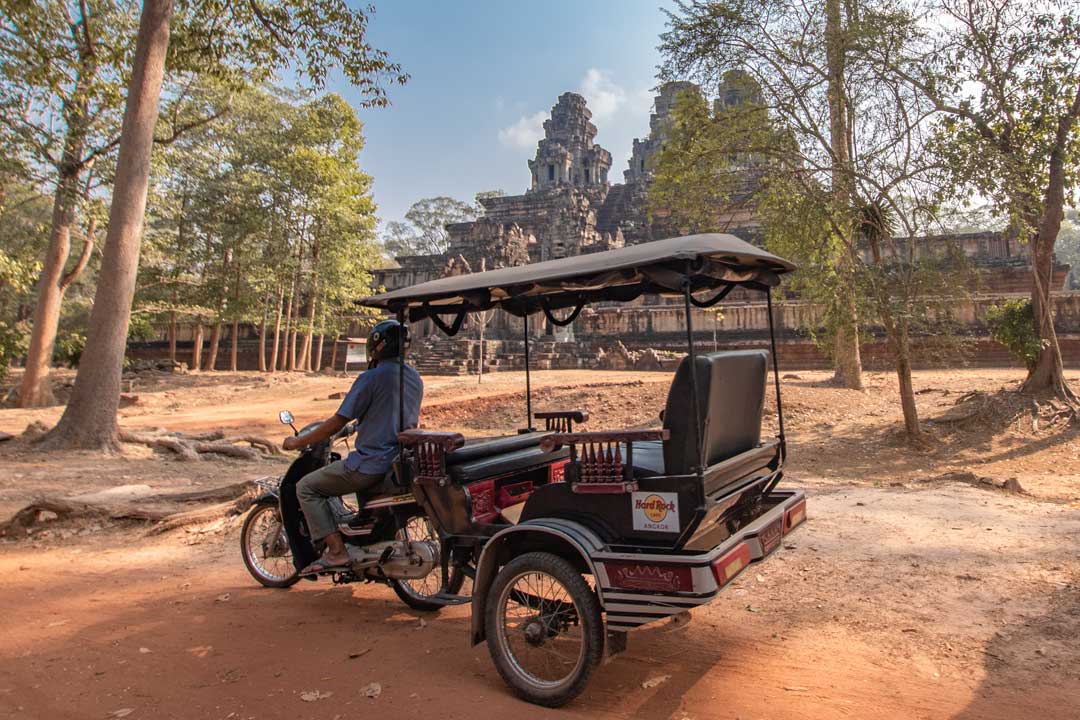
Mr. Thorn ( the friend ) was a cautious driver ( something you would appreciate on the Cambodian roads ). After every temple visit, he was waiting for us with a cold bottle of water and ice-cold wipes. He had some excellent temple advice and was on time every morning, smiling and waiting for us.
To reach Mr.Sok ( or Mr.Thorn ) and guarantee yourself a great tuk-tuk driver, add him as a friend on Facebook first and then write a message ( this way, you can be sure the message will be seen and not sent into the “others” inbox that nobody ever checks ).
Angkor Wat FAQ
What is the angkor wat entrance fee.
There are three types of Angkor Wat tickets: 1-Day pass – 37 USD 3-Day pass ( recommended ) – 62 USD ( The days do not have to be consecutive, this pass can be used on three separate days within one week ) 7-Day pass – 72 USD ( The days do not have to be consecutive, this pass can be used on seven different days within one month ) Tickets are bought only from the official ticket office ( your tuk-tuk driver would lead you there first ), and they have a picture on them. Don’t buy any tickets from the streets or anywhere else. They won’t work.
When is the best time to visit Angkor Wat ?
Ahhh, this is a bit of a tricky one. Angkor Wat is open year-round, but there isn’t really a best time to visit. You’d always have to compromise either with weather or with immense tourist crowds.
For the best weather, December through February is the best time to visit Angkor Wat. Not the hottest of the year but still dry. Those are the tourists months though, so expect to have a large chunk of the 2 million people that visit Angkor Wat every year, there with you.
April and May are hot as hell. Literally…hot…as…hell! The average temperatures are around 35C (95F). Even during the night, it goes a little bit under 30C (37F). If you think you can tolerate such extremes, the tourist crowds would be way more manageable.
From June onwards, the temperatures start to drop, but the rain is becoming more and more often. Cambodia is in the monsoon season. The torrential downpours are usually in the afternoon, leaving the other parts of the day ok for exploring. The showers are quite intense, though. From August through October, Siem Reap receives as much rain as London does for the entire year! If you don’t mind the mud and you’re ready to risk catching a storm or two, the monsoon season would give you pleasant temperatures, low prices, and the smallest amount of tourists possible.
March and November are the shoulder months and maybe (at least on paper ) offer the best balance between weather, tourist crowds, and prices. It’s still a bit of a gamble, though.
Can I use USD in Cambodia ?
The US dollar is an official currency in Cambodia, and it’s accepted everywhere. Just don’t be surprised if you get some change return in the local Cambodian Riel.
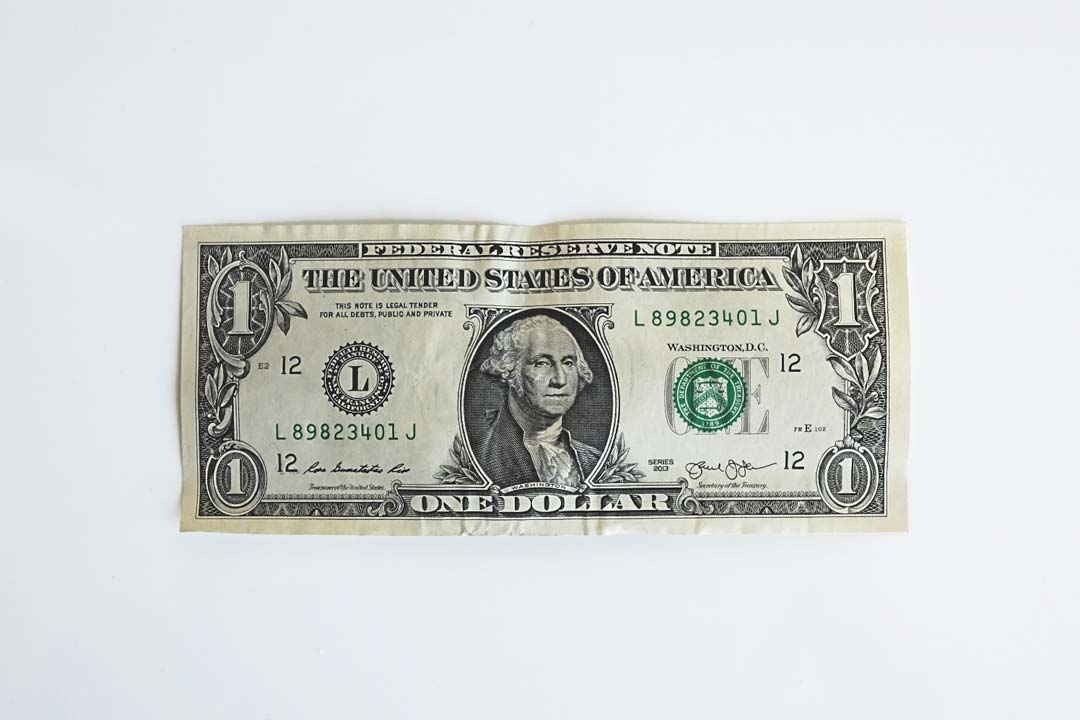
Is one day enough to visit Angkor Wat ?
This one depends on the type of traveler you are and what you expect to see. For me visiting Angkor Wat for just one day is unthinkable. The most popular one-day itinerary is Angkor Wat, Angkor Thom, and Ta Prohm. Going on the most famous Angkor Wat route can guarantee you two things. Huge crowds and a lot of missed things.
The next option is to spend three days exploring the complex. It gives you more flexibility to design your itinerary ( and avoid rush hours ) and also gives you the chance to see more of the wonders of the Khmer. There is a chance that many temples would burn you out, but it’s ( for me ) the best way to see Angkor Wat.
The third option – the weekly pass – is for people who want to explore every detail of the complex and don’t want to rush it. If you have the time and you think seven days of ruins won’t be too much for you, go for it. You’ll explore one of the biggest wonders of the world in a way only a few others have.
What to wear in Angkor Wat ?
Being a religious site, Angkor Wat requires the appropriate attire to visit the temples. Pants should not be above the knee and shirts should cover your shoulders. Tank tops, skirts, shorts, and other revealing clothes are not allowed, and you may be turned away from the temples if you wear one.
Is Angkor Wat open 7 days a week ?
Yes, Angkor Wat is open 7 days a week, 365 days a year.
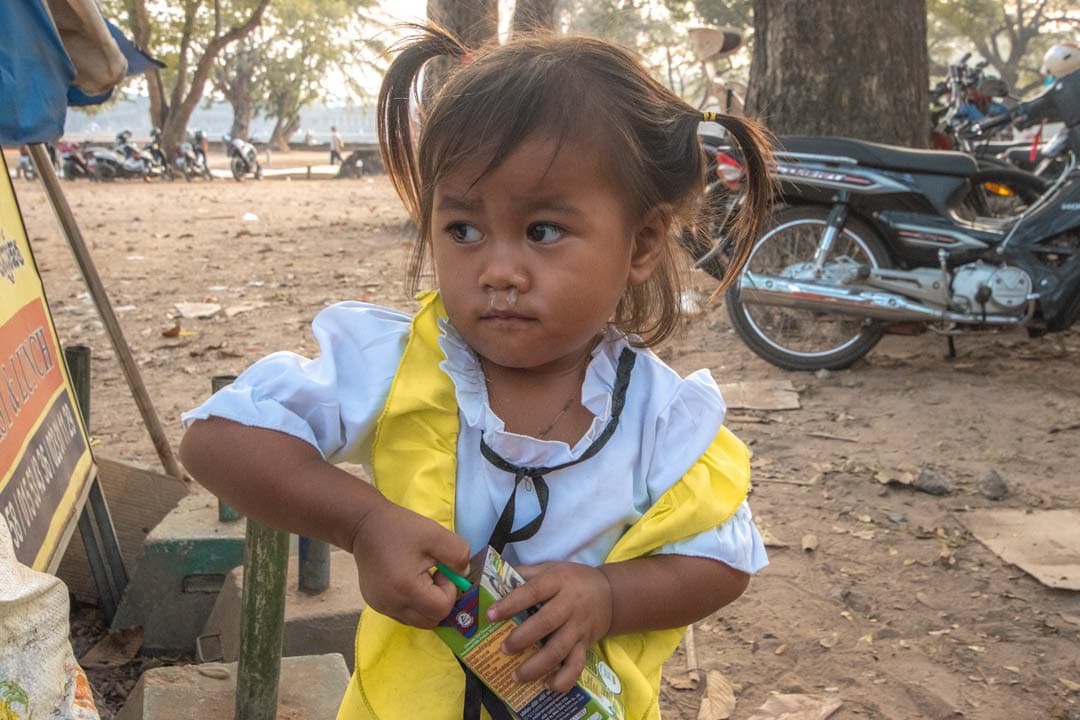
Is Siem Reap safe for tourists ?
It may sound surprising, but Cambodia is an incredibly safe destination to visit. Being the tourist heavyweight of the country, visitors are catered carefully, and crimes are rooted out fast. Just as any tourist place, though, you must always be aware of your surroundings. The violent crimes may be incredibly rare, but petty thefts are not.
A rule of thumb is to not give any money to begging children. As heartless as it sounds, you’d see plenty of kids who would either beg or try to sell you magnets, postcards, and other souvenirs. Buying from them would only encourage this practice to continue, and children to be used as a workforce instead of going to school.
Another rule of thumb is to never travel without travel insurance. I currently use HeyMondo for my travels because they have proven themselves to me more than once over the years. The link above will give you a 5% discount, but If you have another favorite provider, that’s ok. Just make sure you have one because you never know what may happen.
Angkor Wat Itinerary Map
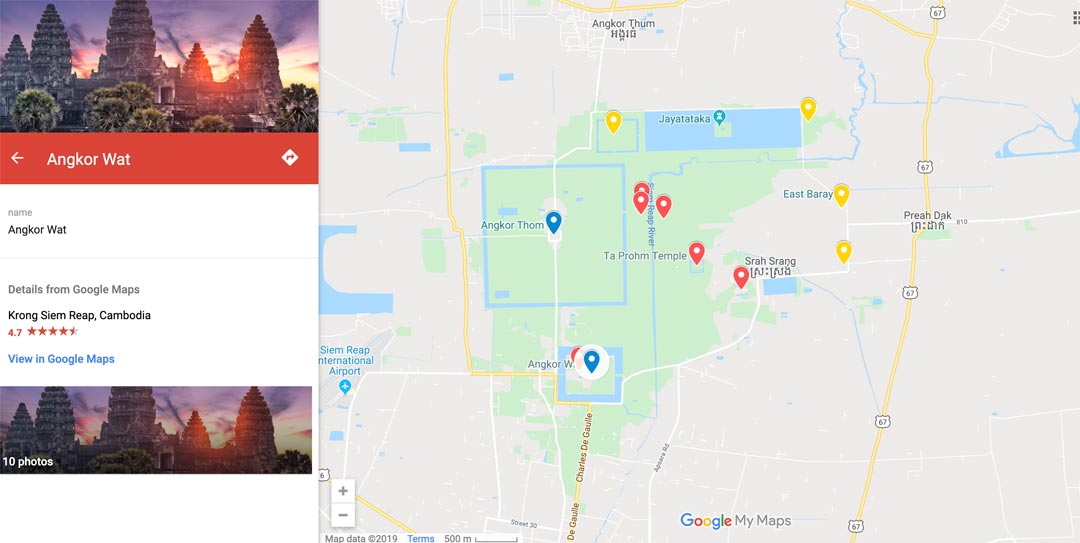
Click to open in google maps
That’s all from me, I hope you enjoy visiting Angkor Wat ! ———————————— If you haven’t planned your trip there yet, find out how I plan my trips! ———————————— I have 11 bucket list ideas for Cambodia. See my impossible bucket list of 1700+ adventures!
Is Angkor Wat on your bucket list?
Some of the above are affiliate links and I will earn a percentage of the sale if you purchase through them at no extra cost to you. This helps keep my site running – so thanks in advance for your support!

Sunday 4th of February 2024
Many thanks for the blog post. We added Mr Sok after reading this and organised two days of driving around the temples of Angkor Wat in February 2024. Great recommendation, he was really great and knowledgeable! Would highly recommend.
Monday 25th of December 2023
Thank you so much for your invaluable info, just back from Cambodia and had an amazing adventure following your advice. I contacted Mr. Sok but didn't get a reply, but found an amazing tuk tuk driver in Mr. Ponleu who was amazing, whatsapp number +855 77 773 425 with excellent English and got me to the temples before the crowds, apart from Angkor Wat of course, like you said that is impossible, but I was on-time and at the front of the lines of folks for the sunrise, and always ready with a cold water once back to the tuk tuk. Thank you again
Sunday 19th of November 2023
Can confirm Mr.Sok is a great choice for a driver :)
Thursday 9th of July 2020
this was a good read for a solo , middle aged traveller hoping to go next year .
Friday 10th of July 2020
Thank you, Jayne! I hope you have the chance to see it, Angkor Wat is truly a remarkable place!
Pin It on Pinterest
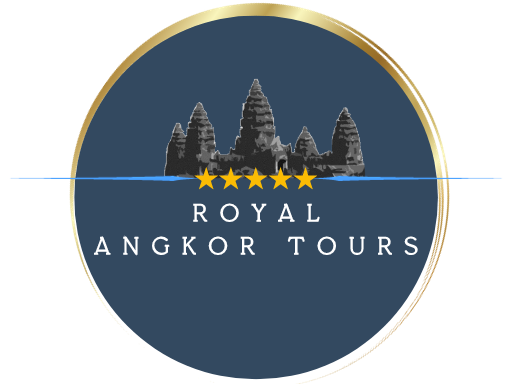
- Best of Angkor Wat Private One-Day Tour
- Book the tour
- Angkor Tours
- Jungle Tours
- Tuk-Tuk / Trike Tours
Value for Money
Time for photos, certified guides, best of angkor heritage, tour description for angkor wat one day tour.
Our amazing private Angkor Wat private one-day tour brings you to the most famous and most beautiful sights of the Angkor Archeological Park. You’ll also discover some less known temples off the beaten track. Experience iconic Angkor Thom – the former capital of the Khmer Empire offering various sights such as the Bayon- the unique temple of the smiling stone faces, the jungle temple Ta Prohm – often referred to as the Tomb Raider temple, and stunning Angkor Wat – the world-renowned pagoda temple. Our certified guides will take you on an unforgettable journey, providing an in-depth and personalized experience.
We offer you a tailored tour. The tour description shows our suggested tour which we consider best. If you have special requests like late pick-up, lunch at a local restaurant or you want us to plan the least crowded route of Angkor, let us know.
Prices per Group for Angkor Wat One Day Tour
Gallery of the angkor wat one day tour.
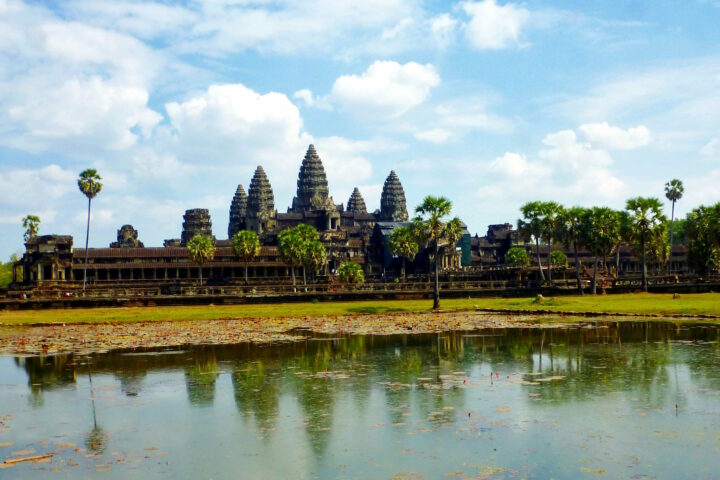
Book this private tour now
CHAT WITH US ON WHATSAPP
EASY & SAFE ONLINE BOOKING
CONTACT US FOR YOUR CUSTOMIZED TOUR
Tour Details
Start after breakfast or for sunrise over angkor wat:.
Pick-up at your hotel: Choose your pick-up time after breakfast or early departure from your hotel at 04:30am to experience the unforgettable sunrise in front of Angkor Wat, the world-famous temple-complex. The whole archeological site extends over 400 square kilometers / 154 square miles and was declared UNSECO world heritage in 1992.
Breakfast: After seeing the colors of the sunrise reflecting in the lakes in front of the unique architectural structures of Angkor Wat, you can decide if you want to go back to your hotel to have breakfast or if our guide should recommend a restaurant.
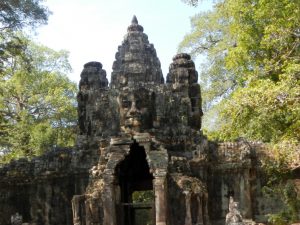
Angkor Thom:
After breakfast our driver will bring the group to the South Gate of Angkor Thom. It is the most beautiful and best preserved of the five entrances to Angkor Thom, the biggest complex of the Angkor Archaeological Park. The royal city Angkor Thom was built in the late 12th to early 13th century.
Bayon Temple: Here you will visit the main temple Bayon built by king Jayavarman VII. It is famous for its 37 towers with sculptural decorations many of them with the iconic faces carved into the rocks.
Terrace of the Elephants: As you would guess by the name this site is formed by three platforms surrounded by stone carved elephants and the portrayal of an elephant hunt.
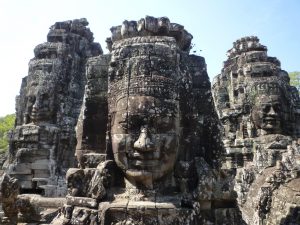
Terrace of the Leeper King: It is said to be one of the most beautiful Khmer artworks. The name comes from king Yasovarman I who built the first city of Angkor and died of leeper. The relief is very detailed an well preserved.
Phimeanakas: The royal temple is one of the smallest temples of Angkor. On top of the 12 meters / 39 feet high Pyramid you have a great view on the whole archeological site of Angkor Thom.
Lunch break in the Angkor area:
You can decide where you want to have your lunch and whether you prefer local food or international cuisine. Grilled seafood, a Khmer Curry or a steak with fries, it is your decision.
Ta Nei Temple
This small temple is about 4.5 km/ 2.8 mi from Angkor Wat and doesn’t belong to the main tourist areas of Angkor because tour buses don’t reach the site. Therefore it is not so crowded and you have space to explore the temple of king Jayavarman VII with your guide.
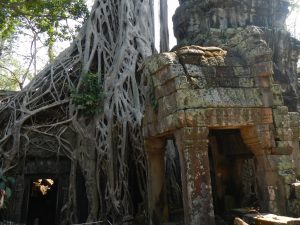
Before exploring the most famous temple Angkor Wat, our driver will bring you to Ta Prohm, the “Jungle Temple”, which was built by Jayavarman VII to honor his mother. The temple got swallowed by the jungle. The impressive Bayon architecture merges with the jungle. It is especially famous because of the movie “Lara Croft: Tomb Raider” featuring Angelina Jolie. It is an unforgettable set-up of nature taking in a former civilization.
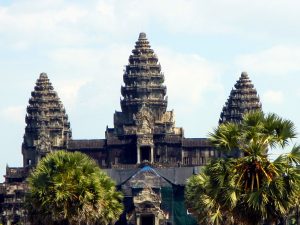
Angkor Wat:
After a short ride you will explore Angkor Wat, the most famous temple of the Angkor Archaeological Park. Angkor Wat with its Pagoda was once the center of the powerful Khmer kingdom. You can climb the steep steps to go up to the tower and have a magnificent view over the Angkor heritage site. Your guide will tell you the interesting stories of the Khmer empire and the kings from long ago. One thing is for sure. You will not get bored. Maybe your feet will get tired but this UNESCO world hertiage is worth the effort.
Drop-off at the hotel
Our driver will bring you back to the hotel.
Tour Itinerary
You May Also Like
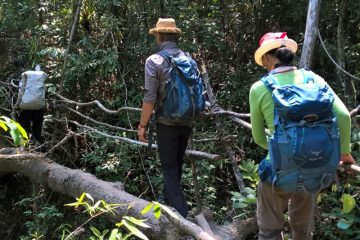
Cardamon Mountains: 4 Days Eco-Trekking in the Rainforest
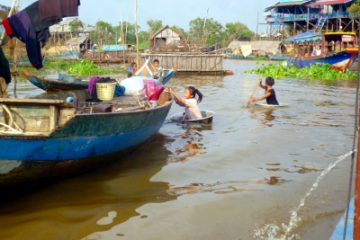
Tonle Sap & Floating Village One Day Boat Tour
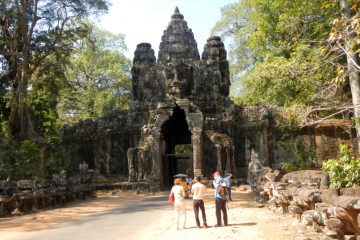
Highlights of Angkor Wat Private Two-Day Tour
- Search Search Search …
- Search Search …

Angkor Wat Guide [Visit Independently + on a Tour]
We’ve visited the temples of Angkor twice now. We’ve visited Angkor Wat independently, and we’ve also explored Angkor Wat on a 2 day tour. We’ve seen sunrise here, and we’ve seen sunset at Angkor. While we learned a lot on our first visit, traveling independently, hiring our own tuk-tuks, and finding a guide at the entrance, our experience the second time was much deeper and informed. This is not a difficult place to visit, it can (and will) be busy. Millions of people visit Angkor every year. So our Angkor Wat guide looks at how to try and avoid crowds, making sure you don’t miss the highlights, and ensuring that you’re in the right frame of mind when you do get there. It’s easy in the sweltering heat of Cambodia to get exhausted and fed up. But Angkor is worth it. Ready?
THIS POST MAY CONTAIN COMPENSATED AND AFFILIATE LINKS MORE INFORMATION IN OUR DISCLAIMER
TOP WAY TO VISIT

Angkor Wat 2-Day Tour with Sunrise
Discover the temples of Angkor, representing 600 years of Khmer civilization. Learn about one of Asia’s greatest kingdoms from your historian guide and see major temples including sunrise & sunset.
Head out for a wonderful and informative time – but book early.
In 2024, a one day ticket costs US$37, a 3 day ticket US$62 and it is US$72 for 7 days. A few years ago on our first visit here, we bought the one day ticket, we toured independently, and at the end of the day, we agreed we needed more time. It took us some time to get back here, but we did and on our second visit, we opted for the 3 day ticket and also a 2 day guided tour which explained so much that we had entirely missed on our first visit.
The Best Way to See Angkor Wat
The best way to explore Angkor Wat and Angkor Complex is going to depend on how interested you are. You can pick up a tuk-tuk from your hotel that will rush you around to the main places to take a photograph if that’s what you’re interested in. You can get a guide at the entrance. You can rent a bicycle and spend an entire week here, or longer if you want. So you’ve got to decide what your interest level is.
If you’re coming here because you want a visit that educates, entertains, and gets you to the key parts of the Angkor Complex, then I recommend this specific tour from Journey Cambodia . It’s a small group tour. Our guide was one of the best that we’ve had in 10 years of traveling. I’ll explain what we saw, how our guide enhanced the visit, and also what our experiences were in visiting the first time when we picked up a guide at the entrance for an hour only as I go through this article.
Let’s start with an explanation of what you’re seeing around here.
What is Angkor Wat?
Angkor Wat is a Hindu-Buddhist complex of temples in Cambodia. More correctly termed the Angkor Wat Archeological Complex, Angkor Wat is the temple complex, that is located within the ancient Khmer city of Angkor. However, the term Angkor Wat is generally used to describe a single temple, the temple complex, and also the area around and near both of them.
The area in question covers 1,626,000 square meters or 402 acres, but in the past, the nature of Khmer building and settlement meant that it was low density and dispersed, so there’s an area of at least 1,000 square kilometers (390 square miles) that extends beyond the major temples covered in this guide to Angkor Wat. This area encompassed roads, canals, and general infrastructure. The area covered by Angkor Wat’s UNESCO World Heritage listing extends to 400 square kilometers (154 square miles)

The area that you’ll visit at Angkor, the complex of Angkor Wat is the largest religious monument in the world. The city was the capital city of the Khmer Empire, which ruled from the 9 th to the 15 th century. At its peak, the ancient city used to be home to more than a million people. The empire fell in 1351 to Ayutthaya (our guide to Ayutthaya is here ) and was sacked in 1431. When Angkor started to decline the royal court was moved to Phnom Penh, Cambodia’s current capital city (our guide to Phnom Penh is here )
Your ticket to Angkor Wat gives you access to the temples, and the Archeological Complex of Angkor Wat, which was inscribed on the UNESCO World Heritage list in 1992.
What’s at the Angkor Temple Complex?
You will find the remains of different capitals of the Khmer Empire from the 9 th to the 15 th centuries, including all the major temples of Angkor and also moats, forests, and canals. Some villages are still inhabited, and they do sit within the wider temple complex. There are agricultural areas and rice cultivation. But you likely won’t want to or need to see all of that.
The major temples that you’ll want to see are
- The famous famous Temple of Angkor Wat
- Angkor Thom
- Bayon Temple
- Banteay Kdei
What to See at the Angkor Wat Temple complex
Regardless of whether you visit the Angkor complex independently or on a tour, there are some key temples and areas that you’ll want to see. I’ll go through these in order of importance to the general visitor.
The Temple of Angkor Wat
This is the famous temple that you see in the first photo in this article. It’s what you see on all the promotional materials for Angkor Wat.
This is the centerpiece of the Archaeological complex. If you see just one temple at Angkor it should be this one. This is also the temple to see sunrise at Angkor.
Angkor Wat is the earthly representation of heaven. Each of the Cambodian kings strove to outdo each other by building temples. No one lived in these temples, they were simply for worship. The culmination of the temple building was Angkor Wat – it’s the world’s largest religious building. The temples in this area (the old capital of Angkor) were built during the period 802AD to 1432.
This is the temple that you’ll want to see at sunrise ( we saw it at sunrise on this specific tour with Journey Cambodia – the tour was great, but the sunrise was not so much).
The first time I saw Angkor Wat, I wasn’t that impressed. We’d arrived around 09:00 and it was seriously hot (yes already) humid and crowded. Perhaps it was the heat. Perhaps it was that there were a fair few people, but my first impression wasn’t jaw-dropping. It was more a little “Oh, that’s it then”.
This wasn’t a Great Wall of China moment.
It became more impressive as we got closer.

The construction really is quite incredible, considering when it was built. It’s amazing how the temple lines up perfectly along compass lines, oriented perfectly to the west. The temple of Angkor measures a perfect square kilometer and has three terraces, which are capped by five lotus-shaped towers. The temple is surrounded by a moat and an exterior wall. The wall measures 1.3 kilometers by 1.5 kilometers.
The towers are typical Khmer architecture and they represent Mount Meru, the home of the gods in Hinduism. The Angkor people were Hindu until the end of the 12 th century when they transitioned to Buddhism.
Unlike the other temples, Angkor Wat was never abandoned to the jungle after the city was sacked by the Ayutthayans and abandoned to the jungle from the early 15 th century. It was mentioned by several visiting Europeans. Antonio da Madalena, a Portuguese friar was here in 1586, there were Japanese settlements here in the 17 th century and Angkor was shown to Europeans who visited.
Even then it was a working monastery and temple.
However, it was the French we have to thank for “re-discovering” Angkor – in the 1860s. Although the Portuguese had also first “discovered” it in 1614. To cut a long story short about different explorers discovering Angkor, the first foreign tourists arrived in 1907.
And then, again, it was the French who began a long restoration process – from 1907 to 1970 the forest was cleared, drains were installed and work was undertaken to protect the buildings from water damage. This stopped in 1970 because of the Cambodian Civil War and the Khmer Rouge (read more about that in our guide to the Killing Fields of Phnom Penh here ).
And, getting back to Angkor Wat.
As well as what I’ve mentioned above, Angkor is famous for sunrise and for its apsaras – that’s heavenly nymphs to you and me.

There are more than 3,000 here, sporting 37 different hairstyles and very shiny breasts. That’s from centuries of visitors trying to rub some good luck onto themselves. Or that’s the myth anyway.
If you’re going to visit Angkor Wat independently, then I recommend buying a specific guidebook about the temples, rather than just a chapter in a Rough Guide or Lonely Planet. I’d recommend
Moon Angkor Wat , or
The Pocket Siem Reap and the Temples of Angkor.
They haven’t been updated in recent years, but you know, to be fair, the temples haven’t had many updates since 1431 either…
The second most popular temple to visit at Angkor is Ta Prohm. Yes. This is the Tomb Raider temple . It’s time to embrace your inner Lara Croft. Yes, Ta Prohm is also known as the Angelina Jolie temple.
Much greener and less manicured than Angkor Wat, Ta Prohm is in an almost arrested state of decay.
Tumbledown blocks seem to be held sometimes almost by magic. Incredibly Ta Prohm was built without mortar and the tree roots curl impossibly in, under, and around buildings.

Your mind imagines them growing, reaching out, and including you in this macabre tableau of decay. They are giant snakes, not solid immovable trunks. They’re very much alive and they’re coming to get you. Moss covers almost everything.

It was Jayavarman VII – the first Khmer king who was devoted to Buddhism – who started the expansion program in Angkor in 1186. Ta Prohm (which stands for Ancestor Brahma) was one of the first temples constructed in this plan. Over the 37 years of his reign, Jayavarman is generally credited with introducing a welfare state for the Khmer people and constructing buildings that included hospitals and rest houses as well as temples. Bayon Temple and Angkor Thom also date from this period.
Ta Prohm was known as the monastery of the king or Rajavihara and the temple was built in honor of Jayavarman’s family, with various areas of the temple dedicated to his mother, father, elder brother, and guru.
When the Khmer Empire fell in the 15 th century, Ta Prohm was abandoned. Even when the French began to restore the Angkor Wat temple it was decided that Ta Prohm would be left in an arrested state of decay. It was felt that Ta Prohm was the temple that had best become at one with the jungle, but not yet part of it. The restoration that has occurred has been primarily to prevent any further decay but also to minimize the effect of visiting tourists on the temple.
As you visit, right from the start, there’s an incredible atmosphere. Each time we visited there were lots of people here and yes it was hot. But somehow there’s still the feeling that the jungle is in control.
And it is possible to get away from the crowds. To find a quiet corner. To take a photograph with no people in it. And yes, even a moment of silence or two.
Angkor Thom and the Bayon Temple
Angkor Thom is the name of (another) ancient city within the area of Angkor, in which there are a series of temples, the most famous of which is the Bayon Temple. Angkor Thom was also built by Jayavarman and it was both his capital and the longest enduring of the Khmer capitals.
The city of Angkor Thom covers an area of 9 square kilometers (3.5 square miles), and at its center is the Bayon Temple. The name Angkor Thom means “Big” or “Great” City” (Angkor means city, and Thom means big). Angkor Thom was the Khmer capital when the area was sacked by the Ayutthaya kingdom, and that’s when the capital moved to Phnom Penh.
The walls around the city are 8 meters (26 feet) high and both the walls and the moat that surrounds them are 3 kilometers (1.8 miles) long. You’ll find a gate to Angkor Thom at each of the cardinal points – north, south, east, and west. There is a further gate, a fifth one, called the Victory Gate, which is 500 meters (1640 feet) north of Angkor Thom’s east gate.
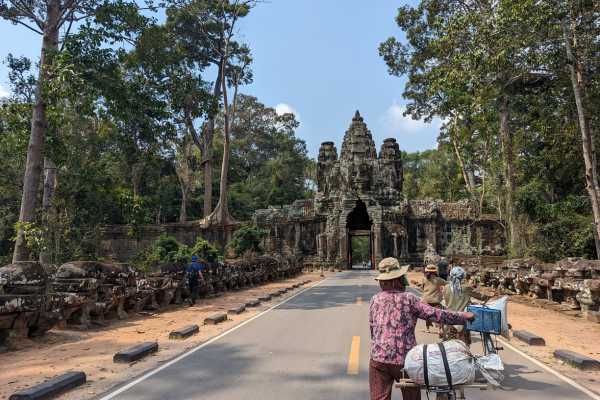
At the center of the ancient city is the Bayon Temple, which was the city, or state temple of Angkor Thom. Interpretively, Bayon is Mount Meru, and the city and the moat are the oceans and mountains that surround Bayon.
You’ll definitely want to visit here for a number of reasons. The first is the causeway and bridge across to the south gate.
The South Gate Deities of Angkor Thom aka the Churning of the Sea of Milk
You will most likely enter Angkor Thom via the South Gate. If you don’t, make sure you leave by it, as this causeway is spectacular. Although it looks like a bridge it’s technically a causeway as the water doesn’t flow underneath it.
As you approach the south gate of Angkor Thom you’ll see what looks like a bridge. And if you look closely you’ll see carved images on the walls on either side. These are Hindu images representing a Hindu myth, the Churning of the Sea of Milk. And the images are different on either side of the pathway.
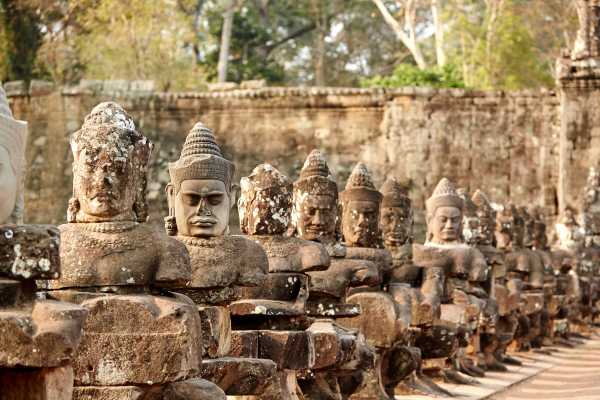
As you approach the south gate, on one side of the causeway (which does look like a bridge) you’ll see 54 devas (or guardian deities) which are pulling the head of a naga or mythical serpent. On the other side, there are 54 asuras (demon gods) which are pushing the tail of the serpent. In this Hindu creation myth, the whipping motion of the body of the serpent churned the ocean and recreated the cosmos. Those apsaras that you saw at Angkor Wat? They were the first beings to emerge from this sea of creation.
Angkor Thom’s Terrace of Elephants.
Inside the walled city of Angkor Thom is another spectacular place to visit – a 350 meter (1150 feet) long viewing platform named “the Terrace of Elephants”. Stories vary as to what this was used for – it may have been where the King viewed his victorious returning army. It may also have been the base where public complaints were listened to by the King.

The elephants are carved in bas relief and there are also carvings of life-sized garudas (a bird-like deity with the body of a human and the wings and beak of a bird) and lions.
Bayon Temple
Bayon Temple is the temple in the center of Angkor Thom. It was also built by Jayavarman VII. The Bayon Temple has 54 gothic towers that display more than 200 stone faces and these faces and the more than 11,000 figures display a combination of what everyday life was like here in the 12 th century as well as historical tales of the time.

Bayon is known as the temple of the faces. But it’s most well-known among visitors for its great views of the surrounding jungle and for this reason alone, it is ALWAYS busy. It looks glorious in the early morning or late afternoon sun,
The temple was originally built for Buddhist worship, but it was later renovated as a Hindu Temple.
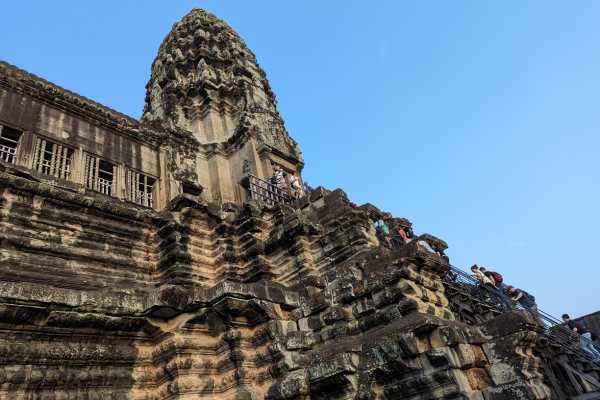
Pre Rup Hindu Temple
This 10 th century Hindu Temple means “turn the body” – the name comes from a common Cambodian belief that there were funerals conducted here, with the ashes of the deceased rotated in different directions throughout the ceremony. The temple was dedicated to the Hindu God Shiva and is on an artificial island in one of the reservoirs of Angkor.

There’s a lot of red brick used in the construction and it looks lovely in early or late light.
You’ll notice the three spires of Pre Rup – and it’s kind of like a miniature Angkor Wat.
To the northeast of Angkor Thom is the temple that Jayavarman VII built to honor his father, Preah Khan. It’s very similar to Ta Prohm, with a state of arrested decay, although you can wander right inside some of the terraces and it does feel rather like some of them might fall on you!
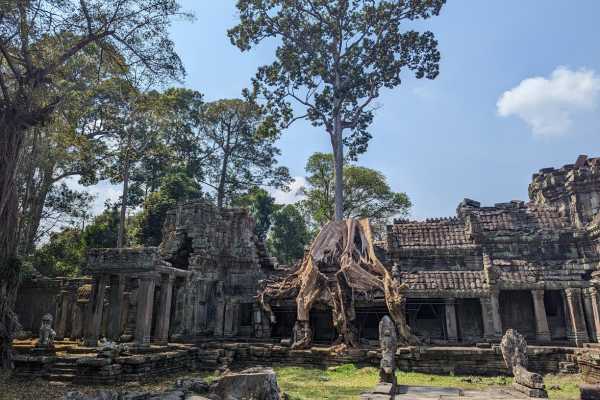
The site of Preah Khan is the location of the battle that Jayavarman VII had with the Chams in 1191. He was victorious. The name Preah Khan translates to “Holy Sword”

Banteay Srei
Another 10 th century temple, this has to be my favourite of the temples at Angkor. It’s quite a distance away from the main temples, some 25 kilometers (16 miles), but you’ll usually find fewer people here (yay!). You’ll probably only get to Banteay Srei if you take a 2 day tour, like this one that we took .
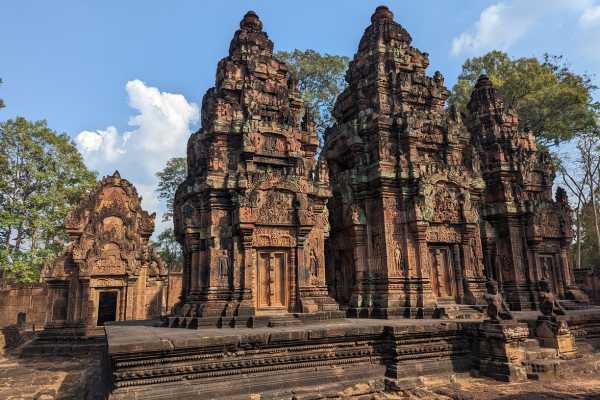
The detail and carving are spectacular. While tourists have been visiting Angkor since the French rediscovered the temples in the 1900s, Banteay Srei has only been open to the public since the Khmer Rouge left the area in the 1990s.
Banteay Srei is carved mostly from hard red sandstone, which can be carved like wood, and compared to the other temples, this is a tiny temple. The lintels and pediments (the triangle bit at the top of a doorway) are gloriously and ornately carved.
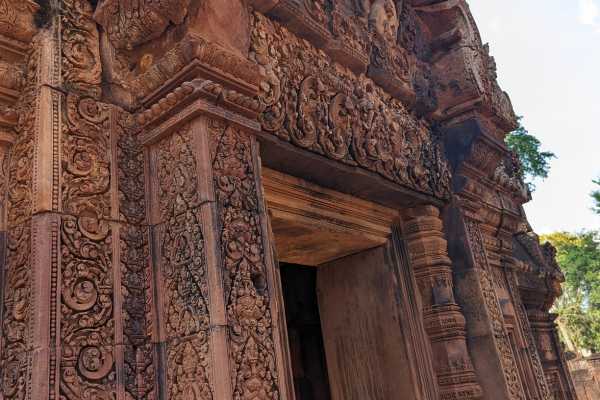
This temple is unusual as it was built not by the rulers, but by a couple of courtiers and its name translates as “Citadel of the Women”, or sometimes “Citadel of Beauty”. And it is a beauty.
Phnom Bakheng.
If you’re planning on seeing Angkor Wat at sunset, then the best place to see a sunset is Phnom Bakheng. Some tours, like this one , include stopping at Phnom Bakheng in your tour. On our first visit here, our tuk-tuk drivers didn’t include staying this late, but we paid them extra to stay while we watched the sunset and rode back in the dark. You’ll want to pre-arrange a ride back to Siem Reap if you want to see the sunset here, as you’re unlikely to find a driver just waiting around for a fare.
Phnom Bakheng is the oldest temple in the Archaeological Complex, built in the 9th century, it has symbols from both Hinduism and Buddhism and again represents Mount Meru. You’ll leave your transport at the bottom of the hill and need to walk up the wooded, paved slope, to get to the temple.
Numbers are limited now to around 300 people, to protect the structure AND the visitors.
Seeing Angkor Wat at Sunrise
The best place to see Angkor Wat at Sunrise is the “Reflecting Pool” in front of Angkor Wat. And despite all those photos on Instagram and other social media sites, you won’t have it to yourself. The Angkor Wat complex opens at 05:00. The time of sunrise at Angkor Wat varies from 05:30 to 06:30 depending on the time of year that you visit.

If you’re taking a tour that includes sunrise then you’ll get there in plenty of time. If you’re traveling independently, then you’ll need to leave your hotel in Siem Reap around 04:45, but you can check the sunrise times for Angkor Wat here. Note that you’ll see the sunrise times for the city of Siem Reap, which is the closest city to the complex. Our guide of what to do and where to stay in Siem Reap is here.

Seeing Angkor Wat at Sunset
The most popular place to see sunset at Angkor Wat is Phnom Bakheng. It is inside the Angkor Complex, so you do need your ticket to enter here. If you’re touring independently, then you’ll need to have transport arranged to go back to Siem Reap. It will be dark when you leave, and there’s a mass exodus from the park after sunset. It’s not a pleasant bicycle ride at this time.
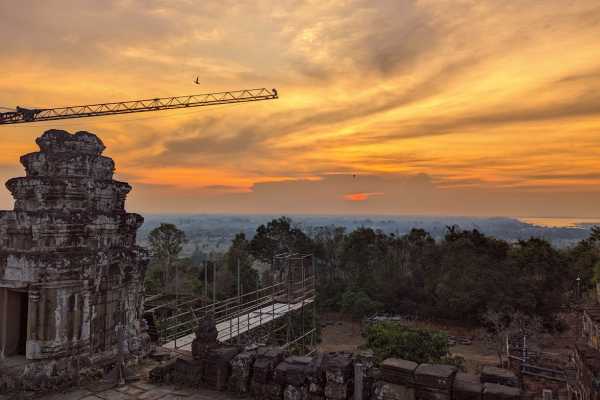
There is a limit to the number of people who are allowed onto the temple platform, so you’ll want to get here about 30 minutes before sunset if not earlier. If you’re taking a tour, then check if this is included. If not, then you can have your guide arrange transport back and just pay cash for the ride back to Siem Reap. It’s usually a one-off cash payment of about US$4 per person.
FAQ about Visiting Angkor Wat
Here are the questions that we get asked about visiting Angkor Wat – don’t forget if you have a question about how to explore Angkor Wat you can send us an email, or ask in the comments below and we’ll answer for everyone else to see.
What is the Angkor Wat entrance fee?
You can buy different tickets to visit Angkor Wat. You can buy online ( here ) or buy a ticket at the entrance to the Archeological Park. You’ll need to decide how many days you want to visit.
- A one day Angkor Wat ticket is US$37
- A three day Angkor Wat ticket is US$62
- A 7 day pass to Angkor Wat costs US$72
You can buy with cash OR cards at the ticket office now.
What does Angkor Wat mean?
The name Angkor is derived from nokor (នគរ), a Khmer word meaning “kingdom” which in turn derived from Sanskrit nagara (नगर), meaning “city”. [3]
When is the best time to visit Angkor Wat?
It’s best to visit Angkor Wat in the dry season, which is between November and March.
How do I buy tickets for Angkor Wat?
You can ONLY buy tickets for Angkor Wat either at the entrance gate or online at the official site here .
How big is Angkor Wat?
The Angkor Wat complex measures 1,626,000 square meters, or 402 acres. The specific Angkor Wat Temple measures 215 x 187 meters (705 x 614 feet), but the moat around it is 5 kilometers (3 miles) long and the outer wall around this specific temple is 3.6 kilometers (2.2 miles) long.
Is one day enough to visit Angkor Wat?
If a day is all you’ve got, then it’s enough to visit Angkor Wat. Don’t NOT visit because you can only spare a day. I recommend two days to visit Angkor Wat. Make them long days – and see Angkor at sunrise AND sunset.
How many days do you need to visit Angkor Wat?
I think two days is a good amount of time to visit Angkor Wat. You can buy a three day ticket, which means that if you bump into too many people, or the weather is bad, or you just can’t deal with the heat of the jungle, you can come back for a 3rd day.
What to wear in Angkor Wat?
There’s a specific dress code at Angkor Wat. This entire complex is a religious monument, one of the most important in the world. You need to wear clothes that cover your shoulders and knees. Although there is shade between a lot of the temples, when you actually are exploring the temples, there isn’t much shade. So bring a sunhat. Or an umbrella, which is my favorite way of avoiding the sun in Asia. (and yes it comes in handy for downpours too).
And you’ll need decent walking shoes, you’re going to be covering a lot of ground. Even if you’re taking a guided tour that provides transport between the relevant temples.
Is Angkor Wat open 7 days a week?
Yes. Angkor Wat is open 7 days a week. It’s open 365 days a year, including all national holidays. Opening hours depend on the temple. Most Angkor Wat temples are open from 07:30 until 17:00, but several are open for sunrise and sunset.
Which Angkor Wat Temples are open for sunrise?
Angkor Wat, Srah Srang, Pre Rup, and Phnom Pahkeng temples are open for sunrise (which means 05:00)
Which Angkor Wat Temples are open for sunset?
The Pre Rup and Phnom Bakheng temples are open for sunset, which means until 19:00
Angkor Wat Map of Temples
You can see the full map of Angkor Wat temples here.

Travel Tips for Exploring Cambodia
- Considering travel insurance for your trip? World Nomads offers coverage for more than 150 adventure activities as well as emergency medical, lost luggage, trip cancellation, and more .
- Get online immediately with an eSIM for Cambodia
- Download and install a VPN BEFORE you travel to Cambodia > discount coupon here
- Arriving by air? Book your airport transfer with Welcome Pickups here.
- Book the best Cambodia tours and guides on Get Your Guide
- Save money in Cambodia with a Wise debit card
- Read about getting around Cambodia in our guide to Cambodian Transport
- Book Buses in Cambodia with 12goAsia
- Book accommodation in Cambodia with Booking
Final Words in Our Angkor Wat Guide
The temple complex at Angkor Wat is spectacular. It is vast and full of history. A visit here is incomparable. And we’ve seen a lot of temples in our time. So whether you come to Angkor Wat for one day or longer, whether you take a tour, or whether you visit independently, just come. And explore. It’s a stunning place to visit.
We receive a fee when you get a quote from World Nomads using our affiliate links. We do not represent World Nomads. This is not a recommendation to buy travel insurance.
ASocialNomad is a participant in the Amazon Services LLC Associates Program, an affiliate advertising program designed to provide a means for sites to earn advertising fees by advertising and linking to amazon.com, amazon.co.uk, and amazon.ca. Amazon and the Amazon logo are trademarks of Amazon.com, Inc. or its affiliates. As an Amazon Associate, I earn from qualifying purchases .
Sarah Carter
Leave a comment cancel reply.
Your email address will not be published. Required fields are marked *
Save my name, email, and website in this browser for the next time I comment.
Privacy Overview

- Free hotel pickup
- Car with A/C
- Free cold water
- Cold towels
- Angkor Wat Photography Tours
- Angkor Wat Sunset
- Airport Shuttle
- Angkor Wat Sunrise
- Experienced tour guide
As well you contact us by phone under +855963333215
Let's connect, angkor wat temples.
- Temple Maps
- Angkor Wat Goodreads
- Angkor Wat Passes
- The History of Angkor
Getting around Siem Reap
- Siem Reap Map
- Siem Reap Airport
- Paying for transport
Private Pool Villa
- Villa Eternal
- Terms of Use
- Privacy Policy
- Refund Policy

A Cambodian adventure to Angkor Wat and Siem Reap
Explore the historical and colourful sights of cambodia’s second-largest city.
A s the gateway to Angkor Wat, Siem Reap might seem like a place you pass through on your way to something more interesting nearby.
- SEE MORE Cambodia: from tenth-century temples to mid-century modern
But this unsuspecting city is the second largest in Cambodia and people have lived here for around 1,200 years. For those travellers willing to spend an extra few days enjoying the surrounding area, there is so much to offer.
A ‘magical experience’ at Angkor Wat
Ok, you can’t go to Siem Reap without visiting the 900-year-old temple that made the town famous, so let’s get that one out of the way first. There are very few things that can make me wake up at 3am, a flight being the main one, but by far the best reason I ever had to set my alarm at that ungodly hour is to watch the sunrise at Angkor Wat.
Taking a guide isn’t necessary, but they do know exactly where to find the best views. We arrived in complete darkness and were told to sit on a wall. The lake below us was only visible when a fish broke the surface, creating ripples that reflected in the moonlight, but soon the sky began its journey from deep purple to the warmest pink and the temple’s ancient towers came into view. Watching a fiery sun rise above this site is a magical experience I will remember for the rest of my life.
Our guide Dalign spent the next four hours showing us around three of the most famous temples, highlighting some of the most interesting bits of history and architecture. Between nuggets of information about Angkor’s history were stories of his own experience growing up locally in the shadow of the Cambodian civil war and the Khmer Rouge. You can book Angkor Wat tours with Journey Cambodia through Get Your Guide .
Panoramic Images/Alamy Stock Photo
Things to see and do in Siem Reap
Some people travel here just to see Angkor Wat and don’t enjoy the town. That would be a mistake. There’s so much to see and do in Siem Reap. To get around, take a rickshaw tour of the town for approximately $20 for half a day. This will be the best way to travel when it gets hot – and it gets really, really hot.
If you are interested in all things military, or in the history of the Cambodian civil war, then head to the War Museum . On display you’ll find tanks, weapons, grenades, and many other items left behind after the fighting stopped. Unlike other more polished museums, these items are available to touch, hold and really get to grips with, giving a very personal insight into the atrocities that occurred here.
Simon Rinderer/Alamy Stock Photo
The Angkor National Museum will give you an even deeper understanding of the Angkor Wat temple complex, and it is dedicated to preserving the archaeology of the area, as well as sharing the complex history of the Khmer civilisation that built and lived in it. One of the newest attractions is the Angkor Eye, a 278ft-tall ferris wheel that has panoramic views over the town towards the temples of Angkor.
You also really must spend one evening of your visit at Phare Circus , an extraordinary celebration of Cambodian culture and dance. It was founded in 1994 by nine young men returning from a refugee camp who wanted to help poor young people. The school now has 1,200 students daily, some of whom end up performing at the circus. The energy and talent on stage is incredible, and the audience of all ages were completely engrossed in a story that told of the importance of the rice fields through song and dance. The site has food and performances before the show as well as a shop selling locally made goods.
Peter Erik Forsberg/Alamy Stock Photo
Where to shop
It is very easy to shop in Cambodia , and there are just so many interesting markets and outlets to explore. The Made in Cambodia market is small but stuffed full of gems that you will want to reserve space for in your suitcase, from craft alcohol to home-made jewellery.
Both the Angkor Night Market and the Old Market are open late and situated right in the centre of the city, and you can find pretty much everything in either. Siem Reap is also home to dozens of interesting boutique stores, from the Australian-owned Wild Poppy, to Manava, which sells chic homewares made by Cambodian women.
Artisans Angkor is a museum, craft studio and shop that gives job opportunities to local people. Helping to revive traditional craftsmanship, we saw how they made glorious silk fabrics, as well as intricate wooden carvings and stonework.
Where to stay
Designed by American architect Bill Bensley, Shinta Mani Angkor and Bensley Collection Pool Villas are located in the leafy French Quarter of Siem Reap near the Royal Gardens, just a 10-minute walk from the city centre.
The resort, which is split into two hotels, prides itself on genuine, personalised service that is high-quality but refreshingly informal. Guests in the pool villas have a private Bensley butler, and the Shinta Mani Spa by Khmer Tonics offers an extensive menu of therapeutic treatments based on traditional and modern healing rituals, using natural, locally sourced products.
The selling point really is the modern and fun interior design, with a monochrome colour scheme and quirky art adorning the walls and halls. Our room was large, with a comfortable king-size bed and sustainable, refillable toiletries. On the ceiling above the bed was a dimly lit picture of Angkor Wat, which was surprisingly nice to look at as I fell asleep.
There are two pools: one is chic and minimalist in a courtyard adorned with greenery and plants, while the other is large and catches the sun all day long. Both have bars serving delicious cocktails to your lounger.
The hotel supports the Shinta Mani Foundation, which helps with education and development of young adults living in the area, and a percentage of every room rate is donated to this.
Where to eat?
Eating in the hotel might feel like a cop out, but not when the restaurant is as special as this. Kroya by Chef Chanrith is a unique dining experience inspired by the area’s rich heritage. We were treated to six courses of elevated Cambodian cuisine. The chef uses local ingredients and knowledge to create a modern menu inspired by the dishes of his youth, and the result is fragrant, exciting, and delicious. A particular highlight was the Tonlé Sap Lake butter-catfish soup and the sautéed Koh Kong scallops with chilli minced pork. We sat on a swing table over a pond full of koi as tuk-tuks and scooters whizzed past, and our waiter Yaya helped make the experience extra enjoyable.
For more traditional local food try Sambo Khmer restaurant, where the Lok Lak, a spicy beef dish, is a particular speciality. Other must-tries are the amok – steamed, curried fish in a banana leaf parcel – and spring rolls.
You can also keep the budget really low by eating at one of the food trucks that park up by the river each evening. Tables and chairs are available for you to eat your street food in comfort, and you will be surrounded by local people enjoying their dinner.
imageBROKER/Alamy Stock Photo
Where to drink?
If partying is your aim then Pub Street has to be your destination. The name was originally thought up by backpackers back in the late 2000s, but it is officially called Street 8. Now it is the centre of nightlife in Siem Reap. Crowds throng along a jumping street full of bars, clubs and, peculiarly, fish pedicure places that offer you a beer as you dangle your feet in tanks of water. It is definitely worth seeing.
If you prefer your evening entertainment to be a little on the lighter side then head down to the river, where bars and restaurants line either side. Sip a cocktail as you enjoy the sunset from one of the many rooftops.
How to get there
Currently, there are no airlines that fly direct from London to Siem Reap, but you can fly via most of the major cities in the region on carriers such as Vietnam Airlines, Singapore Airlines, and Thai Airways.
Jaymi McCann was a guest of Shinta Mani Angkor and Bensley Collection Pool Villas. Rates start from $150 for the Bayon Wing, $165 for Shinta Mani Angkor and $615 for the Bensley Collection Pool Villas. All rates include breakfast and are subject to applicable service charge and government taxes as well as seasonality. Junction of Oum Khun & 14th Street, Siem Reap, Cambodia; shintamani.com
Sign up for the Travel newsletter for destination inspiration and the latest news and trends
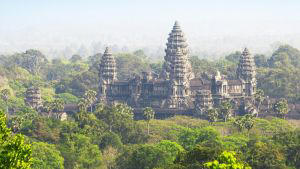

- The Star ePaper
- Subscriptions
- Manage Profile
- Change Password
- Manage Logins
- Manage Subscription
- Transaction History
- Manage Billing Info
- Manage For You
- Manage Bookmarks
- Package & Pricing
The main reason for visiting Angkor is still the mystery that surrounds it
- Asia & Oceania
Tuesday, 23 Apr 2024
Related News

Malaysia will firmly address Israeli violence in Gaza, tensions in West Asia, says Foreign Minister
Ns matrix seal bcl asia spot after beating prawira, vietnam expected to become e-commerce powerhouse in south-east asia, reports nikkei, many tourists head to angkor before dawn to capture beautiful snapshots of the temple ruins at sunrise. — photos: david bowden.
Tourism was identified as a major industry for Cambodia after years of civil unrest, and the listing of Angkor as a United Nations Education, Scientific and Cultural Organisation (Unesco) World Heritage Site in 1992 was key to implementing a national tourism plan for the country.
The jewel in Cambodia’s tourism crown is Angkor Wat, the world’s largest religious site. It’s worth noting that this temple is but one of the many close to the rapidly growing township of Siem Reap. Archaeologists have identified over 1,000 religious sites scattered over the plains of northern Cambodia, with Unesco recognising greater Angkor as a heritage site for all to admire.
Interestingly, the area was declared the Parc d’Angkor or Angkor National Park in 1925. Covering 11,000ha, it preceded the opening of Malaysia’s King George V National Park, which later became Taman Negara, in 1938-1939.
Before the civil unrest in Cambodia, the park was administered by Conservation d’Angkor (now Apsara National Authority).
The first temples in this part of the country date back to the 9th century, with the last being built in the 12th century. During this period, Angkor culture dominated South-East Asia, but it declined for reasons that still baffle the experts. While the Khmer people still used the temples, the forests grew over most of them, and they seemingly disappeared. In the mid-19th century, the temples were “rediscovered” by French explorer Henri Mouhot, although even this is disputed by some experts.
Dedicated temple-goers can spend weeks discovering all the Angkor sites, while others will be able to see the main temples in just one or two days. Organised tours are available, or enthusiastic independent guides with their own transport can be hired at a (usually) reasonable price.
Siem Reap has many other non-temple attractions to make it a complete travel destination. If your budget permits, check into the Raffles Grand Hotel d’Angkor to be graciously immersed in its heritage and have the ever-helpful staff arrange some iconic journeys to the temples and into the region.

It’s in the timing
The monsoon plays a big role in the lives of those residing in South-East Asia, and the situation is no different in rural Cambodia, with the parched dry season being the most desolate time of the year.
The rainy season extends from June to October and reinvigorates the land to enable the rice crop to be planted in order to sustain life for all Cambodians. Tonle Sap, the region’s largest lake, fills and then overflows into the Mekong River system, where an abundance of fish are harvested.
The Angkor is very much a mixed site in that it protects both cultural and natural assets. Indeed, Angkor was a city that some suggest was bigger in its time than London then was. It was also a hydrological society, with large dams or barays that were based on the management of water to enable farming and religious activities. The management of the Unesco site takes into consideration that the local Khmer people live in and around the temples and are still dependent on the land and the forests in their daily lives. There are many faces to Angkor, depending upon the season and the time of day. During the wet season, small depressions within many temple grounds fill with water to present spectacular reflective surfaces for photographs.
Angkor Wat covers an area of 162ha with a moat and laterite walls on its periphery. When viewed from the front entrance, it looks sparsely vegetated, but from the air, or the elevated temple of Phnom Bakheng, the forests are most apparent.
The best times to visit Angkor are to avoid the height of the dry and wet seasons, with the period from November to February being the most popular with tourists. The build-up to the wet season from March to June is very hot and humid and should be avoided.
Temple touring
Access to most of the Angkor temples is strictly controlled, and visitors must purchase access passes. Tourists may be able to check out some of the more remote and lesser-visited temples without purchasing a pass, but only visiting those and not the main ones defeats the purpose of travelling to Angkor. A day pass costs US$37 (RM177), while a three-day pass is US$62 (RM296).
One of the features of most of the sandstone walls is the bas-relief, or three-dimensional engravings. Those of Angkor Wat and the Bayon temple are particularly intricate, with various apsaras, or celestial dancers, as well as numerous carvings that portray Angkor life in the past. Very few apsaras are the same, and there are thousands to be found throughout Angkor, despite many having been illegally removed.

Ta Prohm temple remains entwined by the roots of huge trees, as it was intentionally left by early French archaeologists to show visitors what it looked like in the late 19th century, when they began documenting the temples of Angkor. This is the temple that was used as a backdrop in the 2001 Angelina Jolie movie, Lara Croft: Tomb Raider.
Then, archaeologists faced the dilemma of either letting the destructive forces of biological weathering go unchecked, as nature would have it or stepping in and restricting tree growth. The debate continues in the hallowed halls of global archaeological departments.
Proving that archaeology is alive and thriving, as recently as last year archaeologists unearthed some significant 600-year-old sandstone Buddhist statues buried under the platform at the southern gate of Ta Phrom.
The Elephant Terrace near the Temple of the Leper King is one of the best-restored areas. Local Khmer archaeologists and artisans, with the assistance of foreign experts, meticulously reassembled this part of the Angkor jigsaw puzzle.
Temple town
Siem Reap is the gateway to ancient temples and a civilisation that, at its height, was considered the world’s largest pre-industrial city with an estimated one million residents.
Siem Reap is a town that’s easy to get around on foot or on the back of a motorbike, the most common form of public transport here. Siem Reap was once a town that mostly attracted adventurous backpackers, but now it’s a trendy destination for hip travellers. It has evolved into a tourist town with many activities, from its legendary Pub Street to duty-free shopping, heli-tours, spas and bike tours, in addition to archaeological tourism.
Phare, the Cambodian Circus, is not to be missed, so start the night with sunset drinks, move on to the marvellously uplifting and skilful circus before booking a late dinner.

While visiting Pub Street in Siem Reap is a rite of passage for many young travellers, there are some fine bars, cafés and restaurants here, too, and in other parts of the town. Seek out restaurants such as Spoons, Cuisine Wat Damnak and Chanrey or the numerous hawker food outlets in the Old Market.
Grand accommodation
The exclusive Raffles Grand Hotel D’Angkor has always been the place to stay in town since it first opened in the 1920s. It fell into disrepair during the days of the Khmer Rouge but is now renovated to accommodate those who appreciate life’s little luxuries after a hard day of temple touring.
Raffles is also the preferred address for those who love heritage hotels, as it’s the grand colonial property in town. It has accommodated royalty, writers and movie stars, who were then the equivalent of today’s influencers and key opinion leaders.
The hotel reopened as Raffles in 1997 after a meticulous restoration and refurbishment effort. If the hotel is beyond your budget, at least take time out to enjoy a refreshing beverage in the hotel’s famous Elephant Bar.
It’s amazing how quickly the tourists have returned to Siem Reap after the horrors of the Khmer Rouge and the deleterious impacts of Covid-19. Direct international flights on airlines such as AirAsia have made this easier, but it is the determination of Cambodians for tourism to work that has led to millions of annual visitors discovering the temples of Angkor.
Travel notes
Getting there: AirAsia flies direct from Kuala Lumpur to the new Siem Reap-Angkor International Airport. The new, Chinese-built and funded airport, is located 50km to the east of Siem Reap.
Visa: Malaysians don’t require a visa to enter Cambodia, but some other nationalities do, and visas can be issued on arrival for US$30 (RM143) and a passport photo.
Where to stay: Being the tourist town that it is, Siem Reap has accommodation to satisfy all budgets, but those who want to reminisce the romantic days of grand touring, check out the Raffles Grand d’Angkor (raffles.com).
The mysteries of Angkor
Get off the tourist paths to explore antiquities like the angkor thom east gate, also known as the gate of the dead., angkor wat is one of many temples scattered among the forests on the plains of central cambodia., angkor was once a massive city with agriculture as an integral component., vespa tours of the temples can be organised as a raffles curated journey., ta phrom temple has been left in its original state and is overrun by rainforest trees., unesco protection helps in protecting a few temples from being plundered for their antiquities., sunrise is a popular time for eager temple-goers to visit angkor wat., the grand hotel d’angkor siem reap is the hotel of choice for discerning travellers., angkor is an expansive site surrounded by forests and farm land., one of the features of most of the sandstone walls in angkor is the bas-relief, or three-dimensional engravings..
Related stories:
Tags / Keywords: Angkor Wat , Tourism , Heritage tourism , Unesco World Heritage Site , Siem Reap , historical tourism , Tonle Sap , Angkor National Park , Cambodia
Found a mistake in this article?
Report it to us.
Thank you for your report!

EARTH DAY: GOING FULL CIRCLE WITH PLASTIC
Next in travel.

Trending in Lifestyle
Air pollutant index, highest api readings, select state and location to view the latest api reading.
- Select Location
Source: Department of Environment, Malaysia
Others Also Read
Best viewed on Chrome browsers.

We would love to keep you posted on the latest promotion. Kindly fill the form below
Thank you for downloading.
We hope you enjoy this feature!

IMAGES
VIDEO